
A vast northern landscape: aurora-lit skies, icy fjords, and three towering radiant figures—Enki, Ninmah, and a youthful Odin—gazing down upon early Viking longships below.
THE ANUNNAKI ANALOGS: VIKINGS AND THE GODS WHO WALKED THE NORTH
By Sasha Alex Lessin, Ph.D. (Anthropology, UCLA)
Co-author with Janet Kira Lessin of ANUNNAKI: EVOLUTION OF THE GODS
The Echo of the Gods

Description: Enki and Odin stand together in golden-blue light. Enki holds a water-rune tablet, Odin a staff; their energies interweave, symbolizing shared wisdom.
Long before the Vikings carved their dragon-prowed ships and conquered the seas, the North was already whispering with stories of gods who descended from the stars. These were the Anunnaki, the ancient beings who, according to cuneiform texts, came to Earth in search of gold—and in the process, created humankind.
By the time Scandinavia began to thaw after the Ice Age, legends of luminous beings—tall, powerful, wise—had spread across Europe’s northern rim. They were said to have descended from the sky, their ships glinting like fire across the horizon. Some stories called them Æsir; others spoke of them as giants, or gods. Whatever their name, they left behind something that would echo through millennia: the seeds of civilization, and the stories that would become Norse mythology.
From Nibiru to Asgard

A panoramic view of Asgard—a radiant city in the clouds connected to Earth by the Bifröst bridge. The gods (Odin, Thor, Freyja, Loki) stand before the gates.
In the Viking cosmology, Asgard was a fortress in the heavens, linked to the Earth by a rainbow bridge called Bifröst—a luminous arc said to shimmer with energy and light. To ancient eyes, this could have been a description of a plasma tunnel, an interdimensional gateway between worlds.
Odin, the one-eyed seeker of wisdom, mirrored Enki, the Anunnaki Lord of the Earth. Both were teachers of forbidden knowledge. Odin hung himself upon the World Tree, Yggdrasil, to gain the runes—symbols of divine language and power. Enki, too, risked divine wrath by gifting humankind with wisdom, teaching them to build, to heal, and to dream beyond servitude.
Their defiance marked them as kindred spirits across time and culture: beings who chose compassion and creativity over domination and fear.
The Divine Family Reimagined

Thor mid-action, raising Mjölnir as lightning arcs around him, waves crashing below—a visual echo of Ninurta or Enlil’s storm energy.
The pantheon of Norse deities reflects ancient Sumerian archetypes.
Thor, the thunder god who defended the realms with his hammer, mirrors Ninurta, Enlil’s warrior son—the original storm-bringer.
Freyja, goddess of beauty and battle, resonates with Inanna-Ishtar, whose duality embraced both love and war.

Freyja is portrayed with golden hair and eyes of wisdom, wearing a necklace of amber and tears. Behind her shimmer both the Norse and Sumerian symbols of love and fertility.
And Loki, the cunning shapeshifter, recalls Marduk, Enki’s ambitious son, whose schemes remade empires and unbalanced the cosmic order.
Each of these archetypes carried within them fragments of an older, cosmic story—the saga of the Anunnaki and their long experiment with humankind.

Loki and Marduk reflected in a mirror-like field of energy—two faces of rebellion, firelight flickering around them.
The Dawn of the Viking Age
The written history of the Vikings begins in blood and storm.
In the summer of 793 CE, monks at Lindisfarne Abbey off the coast of Northumbria looked up from their prayers to see sleek, dragon-headed ships cutting through the mist. The raiders who emerged from the fog wielded axes and fire, tearing through the sanctuary with terrifying precision. For the Christian chroniclers who survived, it was as if demons had risen from the sea. For the Norsemen, it was destiny fulfilled.

A cinematic depiction of 793 CE—Viking longships emerging from fog, monks fleeing as torches blaze, the sea aflame with sunrise.
They returned home as heroes, their holds filled with gold, silver, and captives. Each raid inspired another. Soon fleets set sail each summer, pushing farther south and west—to France, Spain, and beyond.
But behind the violence lay something more profound—a yearning to reclaim the lost grandeur of their divine ancestors, to live as gods among men.
From Myth to Empire

Ragnar and Lagertha side by side in battle—fierce eyes, armor reflecting firelight—symbolizing divine masculine and feminine courage.
The Vikings’ sagas blend history and myth until the two are indistinguishable. Ragnar Lothbrok, serpent-slayer and father of kings, was said to descend from the Yngling line, whose bloodline traced back to the gods themselves. His sons—Bjorn Ironside, Ivar the Boneless, Sigurd Snake-in-the-Eye, and Ubba—would carry that legacy into legend.
By the mid-ninth century, Viking armies had overrun most of England. Yet even their most significant conquests could not contain their ambition. In 845 CE, Ragnar’s fleet sailed up the Seine and besieged Paris. A terrified Frankish king paid him in gold to go away.
The Vikings did not merely raid; they colonized, traded, and built. They founded Dublin, settled Iceland, and crossed the Atlantic to reach Vinland—modern-day North America.

Rollo before the gates of Paris, one hand extended in treaty, the other resting on his sword; the city’s cathedral towers in the mist behind.
Their chieftain, Rollo, once a raider, became a ruler. Baptized as a Christian and granted land in northern France, he founded Normandy, the “land of the Northmen.” From his line would come William the Conqueror, who would cross the Channel in 1066 and seize England—completing the saga begun centuries before.
The Last Viking King
Born into a world of shifting alliances and relentless ambition, Harald Hardrada embodied the Viking ideal. At fifteen, he fought in the Civil War. Exiled, he served as commander of the elite Varangian Guard in Byzantium. Later, he seized the throne of Norway and launched one final invasion of England.
At Stamford Bridge, Harald met his end—an arrow through the throat—and with him, the Viking Age died. Weeks later, William the Conqueror landed at Hastings, marking the dawn of a new era.
The Forgotten Women of the North

Women warriors in shining armor form a shield wall; Freyja’s energy glows behind them like a crimson aurora.
Amidst the sagas of kings and warriors, the stories of shieldmaidens shimmer like lightning across forgotten pages. These women trained in battle, stood in shield-walls, and commanded ships. They were not legends, but part of a long lineage of partnership consciousness that predated patriarchal rule—a memory of the Anunnaki matrilineal order, where the feminine was not subordinate but sacred.
In Freyja’s name, they fought, and through them lived the spark of balance—the divine harmony between creation and destruction that Enki’s lineage once championed.
The Sea People and the Cosmic Thread

Leif standing on a green, sunlit coast (North America), raising his arm toward the horizon—hopeful, exploratory, divine guidance above.
Modern archaeology continues to reveal the genetic echoes of this ancient story. A Philistine graveyard discovered in the Levant contained DNA from Northern Europe—a clue that the so-called Sea Peoples, who shook the Bronze Age world, may have shared ancestry with the Norse. If true, the Vikings were not simply medieval marauders, but the latest wave in an ancient migration—one guided, perhaps, by memories of the stars.
Conclusion: The Call of the North
In the end, the Viking story is more than a tale of conquest. It is the continuation of a cosmic legacy—the yearning of humankind to explore, to create, to transcend. From Nibiru to Asgard, from Sumer to Scandinavia, the thread remains unbroken.
Through the Anunnaki, through the Æsir, through us, the saga continues.
⚔️ CAST OF CHARACTERS — Anunnaki Analogs: Vikings, Gods, and the Northern Legacy
ENKI — THE WATER LORD, KEEPER OF WISDOM

NINMAH — THE EARTH MOTHER AND HEALER

ODIN — THE ALL-FATHER OF THE NORTH

THOR — THE DEFENDER, SON OF THE STORM

FREYJA — THE MIRROR OF NINMAH

LOKI — THE TRICKSTER SON

RAGNAR LOTHBROK — SLAYER OF SERPENTS

LAGERTHA — THE SHIELDMAIDEN

ROLLO OF NORMANDY — FROM RAIDER TO RULER
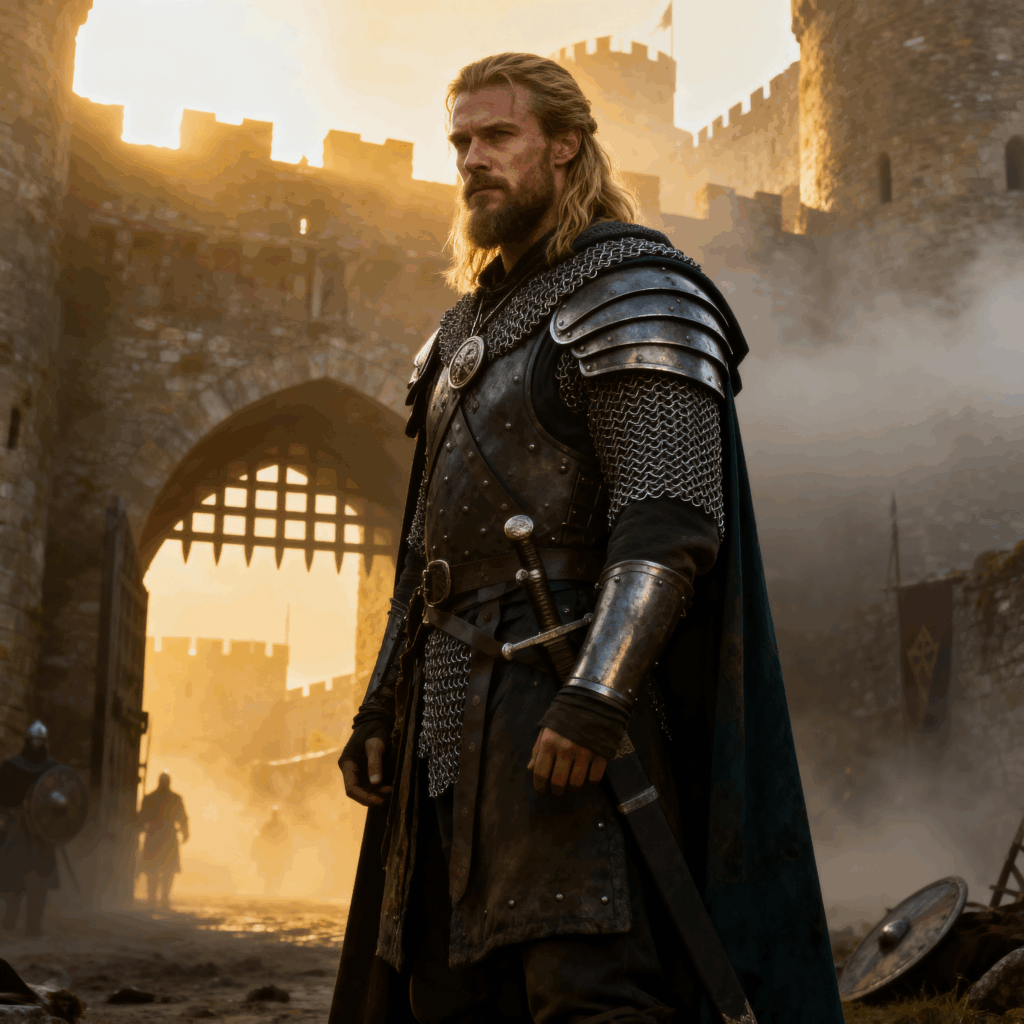
LEIF ERIKSON — THE VOYAGER

SHIELDMAIDENS OF THE NORTH

🌀 READ MORE
Visit DragonAtTheEndOfTime.com and EnkiSpeaks.com for more stories connecting myth, history, and extraterrestrial legacy.
💌 JOIN OUR COMMUNITY
Subscribe to Dragon at the End of Time on Substack for exclusive insights, articles, and research updates:
👉 https://dragonattheendoftime.substack.com
Tags: Vikings, Anunnaki, Norse Mythology, Enki, Odin, Ragnar Lothbrok, Freyja, Ancient Aliens, Partnership Consciousness, Spiritual Evolution, Nibiru, Anunnaki History, Dragon at the End of Time, Sasha Lessin, Janet Kira Lessin
Anunnaki Analogs, VIKINGS, Vandalized Vatican Votaries

A vast northern landscape: aurora-lit skies, icy fjords, and three towering radiant figures—Enki, Ninmah, and a youthful Odin—gazing down upon early Viking longships below.
By Sasha Alex Lessin, Ph.D. (Anthropology, UCLA), co-author (with Janet Kira Lessin) of ANUNNAKI, EVOLUTION OF THE GODS — techno-savvy extraterrestrial people from the Planet Nibiru who came for gold, created us from their genome to work the mines, posed as gods, decided to let us drown, but then decided to breed us to work for them.
Before the longships cut through northern seas, people descended from the Anunnaki settled Scandinavia (around 800 CE).
The Anunnaki were large people. They employed advanced technology combined with developed psychic abilities. They came to Earth in waves from the Planet Nibiru and other Lyran (Homo sapiens sapiens)-controlled planets. This post explores the history of the Anunnaki of Scandinavia, whom we call Vikings.
The Vikings settled Scandinavia. They terrorized people along the Atlantic coast of Europe and along the Danube River, all the way to Turkey.
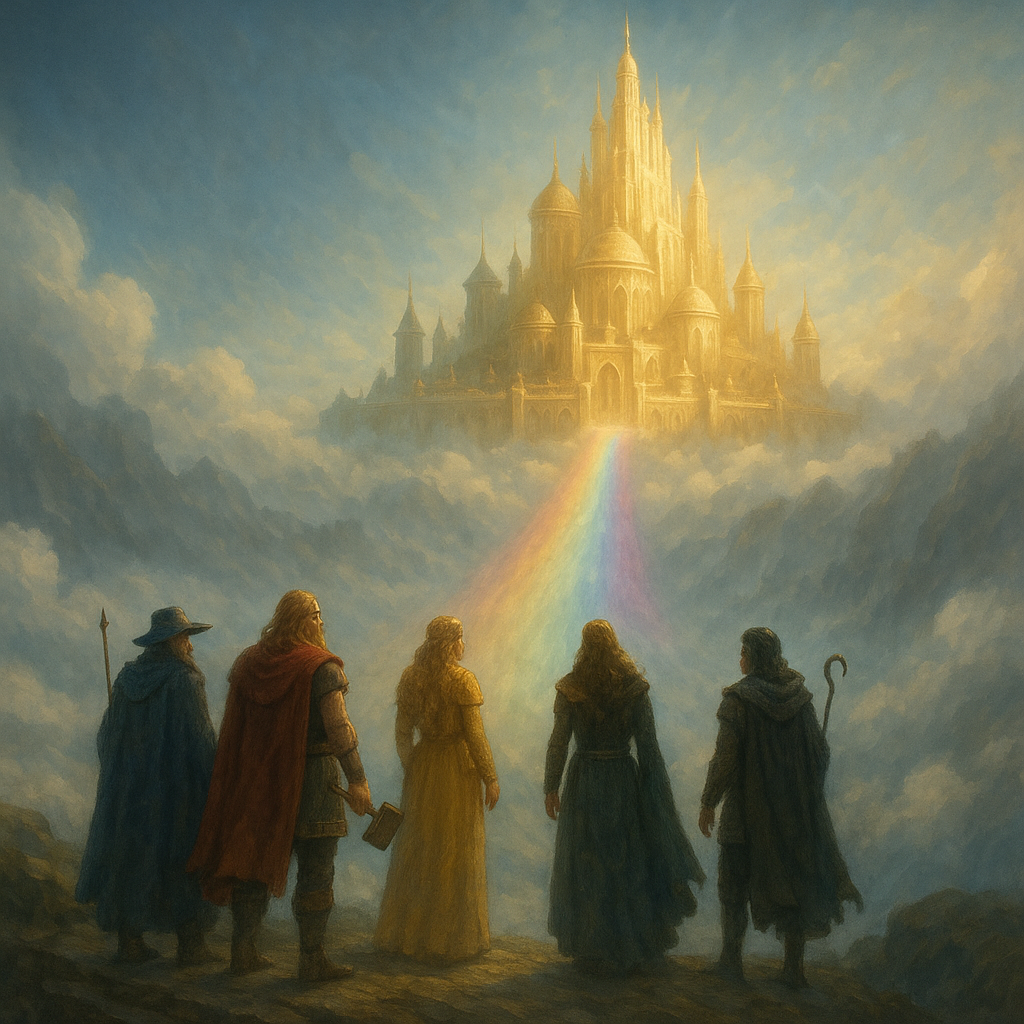
A panoramic view of Asgard—a radiant city in the clouds connected to Earth by the Bifröst bridge. The gods (Odin, Thor, Freyja, Loki) stand before the gates.
In the Vikings’ sagas, they called themselves the Æsir. They lived in Asgard, a fortified realm in the sky, connected to Midgard, the world of humanity, by the rainbow bridge called Bifröst. The Bifröst Bridge was a luminous path of plasma—a space-gate between realms.
Odin, the All-Father, one-eyed and wise, mirrors Enki, Lord of the Earth and keeper of forbidden knowledge.

Enki and Odin stand together in golden-blue light. Enki holds a water-rune tablet, Odin a staff; their energies interweave, symbolizing shared wisdom.
The Scandinavian Odin hung himself to gain the runes. The runes are akin to the Viking version of the Sumerian narrative in which Anunnaki Chief Scientist Enki defied the decrees of his Commander (Enlil), conveyed a diagram for Noah’s ark, and saved humankind from a global flood 13,000 years ago.
Both Odin and Enki embodied compassion for us Earthlings, an emotion that rose above the Anunnaki’s obsession with domination in their heritage.
Thor, hammer-wielder and thunder-bringer, stands as the Norse echo of Ninurta/Apollo, Enlil’s warrior son—the storm-spear, defender of the gods’ order.
Freyja, goddess of love and magic, reflects Inanna (Ishtar), mistress of heaven and battle, both deities of sensuality and war.

Freyja is portrayed with golden hair and eyes of wisdom, wearing a necklace of amber and tears. Behind her shimmer both the Norse and Sumerian symbols of love and fertility.
Loki, the cunning shapeshifter, recalls Marduk, ambitious son of Enki, whose plans upended divine councils and remade empires.

Loki and Marduk reflected in a mirror-like field of energy—two faces of rebellion, firelight flickering around them.
Norse seers taught that Thor, Freyja, and Loki strode across worlds, flew craft, shot fire, and applied knowledge from a place beyond Earth.
Valhalla, the shining hall of the fallen, echoes the Anunnaki heavens as a staging ground for warriors who would rise again in Ragnarök. Sumer was the Anunnaki equivalent of Ragnarök, a place where Earthlings could develop. Enki’s chosen survivors enjoyed a thousand years of civilization-building, which Enki and Ninurta provided after the Deluge, to create what the Anunnaki considered an advanced civilization.
When the Viking Age dawned, the Vikings said they descended from gods and giants, children of Odin-Enki’s defiance. They sought glory and immortality through battle—which most Anunnaki Lords—but not Enki—reified as holy.
Their voyages were not just conquests of coastlines but echoes of a cosmic inheritance—the drive of the Anunnaki within them, ever expanding, ever seeking new worlds.
The Viking Age (793–1066 CE)

A cinematic depiction of 793 CE—Viking longships emerging from fog, monks fleeing as torches blaze, the sea aflame with sunrise.
The Viking Age opened with terror and thunder in 793 when Scandinavian warriors crossed the misty sea to strike the monastery of Lindisfarne off Northumbria’s coast. The monks had no warning. The longships came like ghosts from the fog; blades flashed; sacred relics fell; blood stained the stones of the holy isle. Never before had such a place been defiled—and with that storm of steel, the Viking era began.
Returning home with gold, silver, and slaves, the raiders hailed them as heroes. Their voyages grew bolder each summer, fleets swelling, ambitions rising. To the terrified Christians of Britain and Francia, these “northern devils” seemed omens of the Apocalypse.
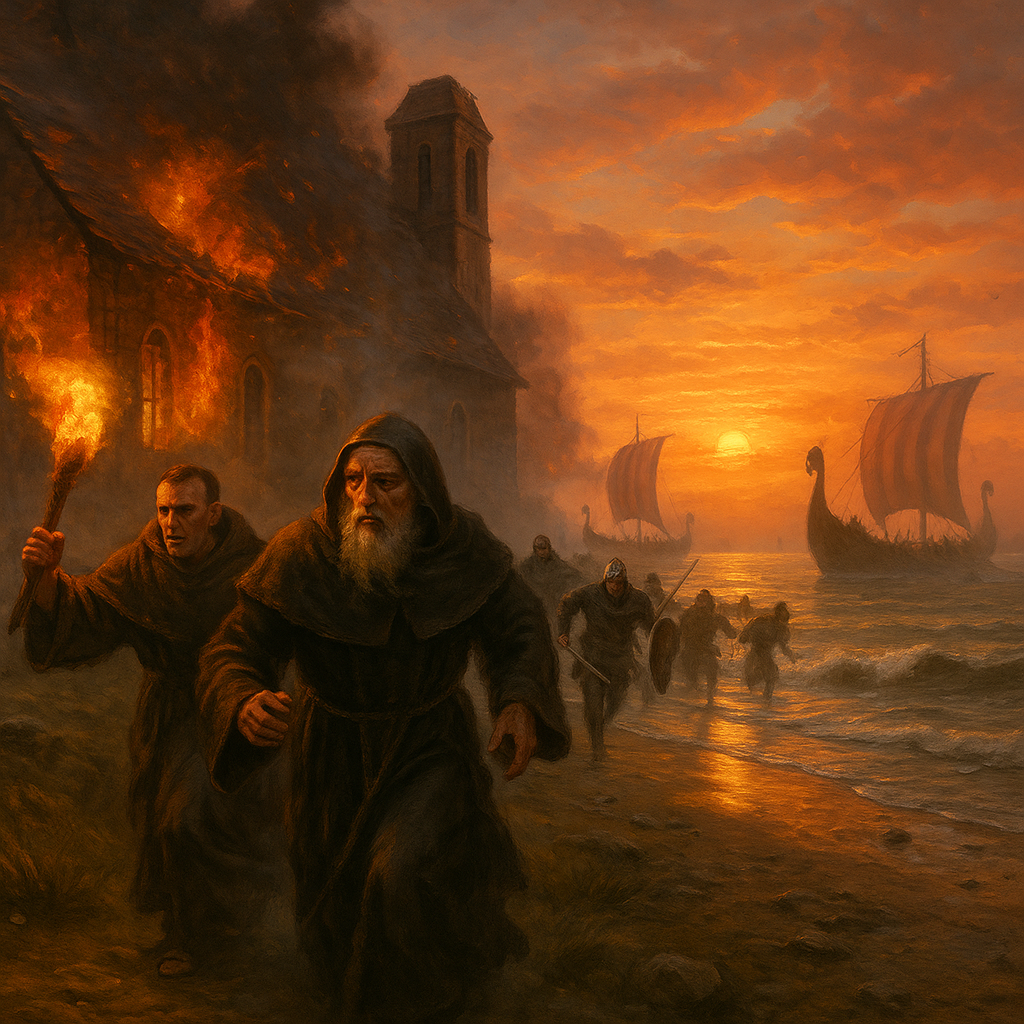
But to themselves, the Norsemen were champions of Odin and Thor, sons of gods who honored courage and despised fear. They sought not salvation, but Valhalla—the warrior’s paradise beyond the veil.
Most Scandinavians, however, were not warriors but farmers, craftsmen, and traders. Their lands were beautiful yet harsh—thin soil, long winters, and hungry mouths. Necessity drove them to explore Iceland, Greenland, and the British Isles. First, they plundered. Later, they built colonies for fertile Earth and lasting homes.
THE VIKING ERA AND THE INVASION OF ENGLAND
🖼️ THE VIKING INVASION OF LINDISFARNE

In 793, a band of Scandinavian warriors braved the uncertainties of an unknown sea in search of treasures they believed the gods promised them. These fierce seafarers had long heard of the rich lands and monasteries of the western isles. Driven by ambition and divine fervor, they set sail toward destiny.

Description: Vikings emerging from fog in longships, torches blazing, monks fleeing, monastery aflame at sunrise.
Off the coast of Northumbria, they came upon the Holy Island where the monastery of Lindisfarne stood. The unsuspecting monks went about their devotions, unaware of the storm that approached. The Vikings landed and fell upon the monastery with merciless force, slaughtering the defenseless clerics and plundering everything of value. The assault was unlike anything Britain had ever known. Never before had anyone dared to desecrate such a sacred site. The Vikings took those few Brits who survived as slaves. Word of the atrocity spread swiftly across Europe. Fear gripped the Christian realms. The age of the Vikings had begun.
When the raiders returned home, their villages hailed them as heroes. They brought with them riches beyond imagination—jewels, precious metals, spices, and slaves. Their daring proved immensely profitable. Greed, glory, and the yearning to match the fame of the first explorers soon filled every heart in the North. Each summer, more ships set sail, more warriors crossed the sea, and more Christian coasts fell under their blades. The terror of these northern men spread through Brittany and England, leading many to believe that Judgment Day itself was near. In their prayers, the frightened Christians begged deliverance from the dread of the Northmen.
But the Vikings feared neither death nor the Christian God. They worshiped their own warlike deities—Odin, Thor, and others—who rewarded courage, valor, and defiance in battle. To die fearlessly with sword in hand was to earn eternal glory beside Odin in the golden halls of Valhalla.
Yet, not all Scandinavians were warriors. Most were farmers, traders, and artisans who lived peacefully and valued art and family. Their culture was rich, with a complex faith that revered not only gods of war but also gods of fertility and the harvest. Spiritual growth was an honored pursuit. Still, life in the North was harsh. Norway’s rugged mountains and poor soils, along with its long winters and isolation, made survival difficult. Many sought better lands, and so began the great migrations to Iceland, Greenland, and the fertile British Isles.
THE GREAT HEATHEN ARMY MARCHES ON YORK
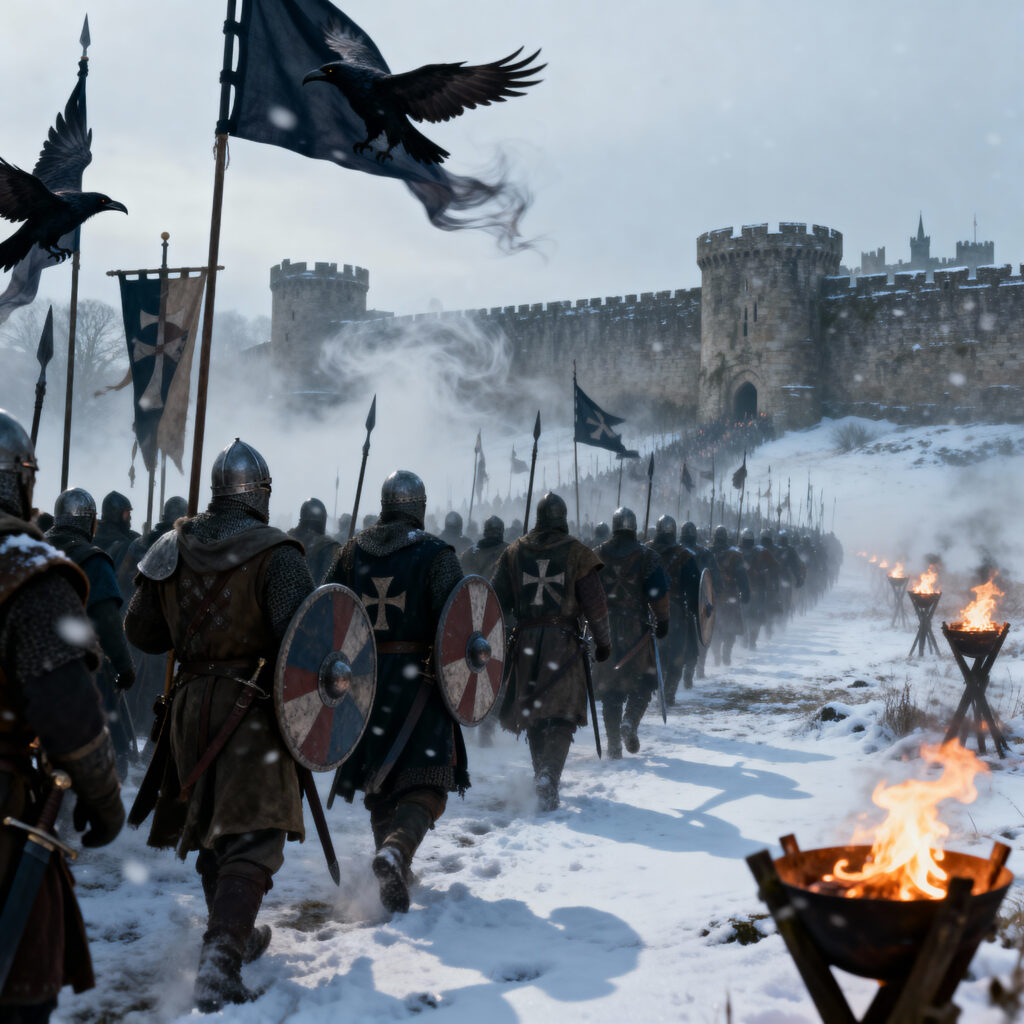
A panoramic view of the Great Heathen Army approaching York — banners of ravens, snow swirling, Anglo-Saxon walls in the distance, torches and shields reflecting firelight.
After decades of raids, the people of Britain grew accustomed to the cycle of summer invasions. Each year, they fortified their defenses, endured the plunder, and tried to rebuild before the following season. But in 865, a new and far greater danger appeared: the Great Heathen Army, commanded by the sons of the legendary Ragnar Lothbrok. Their goal was no longer mere plunder—it was conquest.
At the time, several smaller kingdoms ran England, each wary of the others. Their disunity proved fatal. The Vikings exploited these rivalries, forging alliances through intimidation and diplomacy alike. Some Anglo-Saxon nobles, facing annihilation, agreed to pay tribute and even send soldiers to join the invaders. One by one, kingdoms fell or surrendered.
In 866, the Great Viking Army marched on the city of York, the mightiest in the North. Even the old Roman walls could not withstand their fury. Taking advantage of a Christian holiday, the Vikings struck without warning, seizing the city and subduing the kingdom of Northumbria. From there, they advanced across England, extracting riches and loyalty from those too fearful to resist. Though their army was not large enough to rule every captured territory directly, they installed puppet kings who governed on their behalf and paid heavy tribute.
Over time, more settlers arrived from Scandinavia, and the Norse grip tightened. By the late ninth century, the Vikings controlled nearly two-thirds of England. It seemed only a matter of time before the rest would fall. Yet one kingdom still stood firm: Wessex, the richest and strongest of the Anglo-Saxon realms.
ALFRED AND THE SAXON RESISTANCE

Under King Æthelred and his younger brother Alfred, Wessex organized a coalition of Saxons determined to resist the pagan invaders. Great battles followed—bloody, heroic, and relentless. Both sides suffered terrible losses, but the Saxons did not yield. Exhausted, they agreed to a temporary truce that required heavy tribute payments to the Norse lords.
For a few years, peace held. But soon, a new Viking leader named Guthrum rose and renewed the assault on Wessex. With Æthelred’s death, Alfred ascended to the throne. Intelligent and resolute, he reformed his army, rebuilt his navy, and fortified his kingdom for the inevitable war. His people fought under the cross, believing that their god guided their swords and that it was their divine destiny to reclaim England from the pagan North.
The struggle between the Saxons and the Norse was far from over. The war for England had only just begun.
THE WAR FOR ENGLAND BEGINS
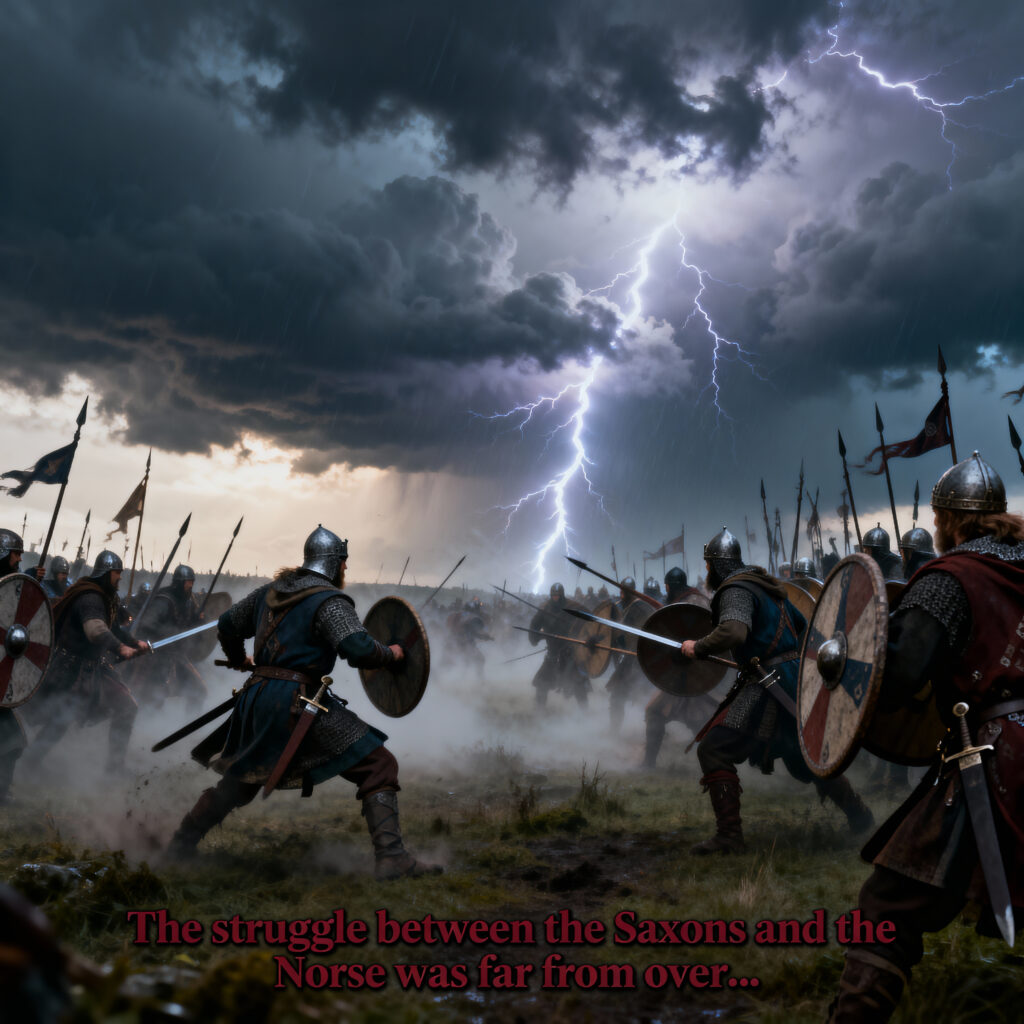
A panoramic clash of forces — Viking and Saxon lines colliding on misty ground, shield walls meeting, thunderclouds gathering above, lightning flashing across the battlefield.
🖼️ RAGNAR LOTHBROK AND LAGERTHA

RAGNAR: SLAYER OF SERPENTS, FATHER OF KINGS

Among the Norse warlords, none cast a greater shadow than Ragnar, the warrior-king of Denmark and Sweden. His grandfather, Randver, was King of Denmark and a member of the semi-divine, Anunnaki-Earthling Yngling line. Born the son of the Swedish king Sigurd Ring, Ragnar descended from the Yngling dynasty—an ancient noble line that traced its ancestry to the gods themselves. The Ynglings claimed descent from Yngvi, son of the sea-god Njord, founder of the sacred temple at Uppsala, a center of Norse worship where kings join the gods after death.
Fro, the King of Sweden, invaded Norway, killed Randver, and forced Randver’s female relatives to work in a brothel. Lagertha, one of the imprisoned women, escaped, donned men’s clothing, and joined Ragnar’s army attacking Fro. Ragnar partnered with Lagertha a while.
Ragnar next rescued Thora Borgarhjort, the daughter of Earl Herraud of Götaland, from a snake guarding her. The Earl had given her a small snake that grew into a large, poisonous serpent. The serpent then enclosed her. Her father promised her hand in marriage to anyone who could slay it. Ragnar beat the serpent by wearing pants boiled in tar to protect himself from its venom; that’s how he took the nickname “Lothbrok” (hairy trousers). Thora died from an illness soon after they wed.
RAGNAR AND ASLAUG — THE TEST OF WIT AND DESTINY

Years later, Ragnar met Aslaug, who appeared as a simple peasant but was in truth the daughter of two legendary heroes: Sigurd, the dragonslayer who slew Fafnir, and Brynhild, one of Odin’s Valkyries. To test her wit, Ragnar challenged her to present herself to him neither dressed nor naked, neither hungry nor full, and neither alone nor accompanied.
Aslaug appeared, wrapped in a fishing net and biting an onion, followed by a dog that fulfilled all conditions at once. Impressed by her cleverness, Ragnar married her. Together they had five sons: Bjorn Ironside, Hvitserk, Halfdan, Sigurd Snake-in-the-Eye, and Ivar the Boneless—names that would become legend across Europe.
Ragnar’s charm and power attracted many women. One unnamed noblewoman bore him another son, Ubba Ragnarsson, described in early sources as “the most beautiful of men ever seen by mortal eyes.”
Paris
In 845 CE, leading hundreds of ships, Ragnar besieged Paris, defying the Franks’ walls and their god. He took tribute from terrified kings—but his victories brought envy and doom.
Northumbria, Northern England
Between 852 and 856, Ragnar shipwrecked on the shores of Northumbria, whose King Ælla threw him into a pit of serpents. As venom coursed through his veins, Ragnar laughed: “How the little piglets will grunt when they hear how the old boar died.”
And so they did. In 865, his sons—Ivar the Boneless, Bjorn Ironside, Sigurd Snake-in-the-Eye, and Ubba—led the Great Heathen Army into England, conquering two-thirds of the land. Through them, Ragnar’s vengeance lived—and his legend endured.
BROTHERHOOD OF THE NORTH — THE COUNCIL OF KINGS AND GODS
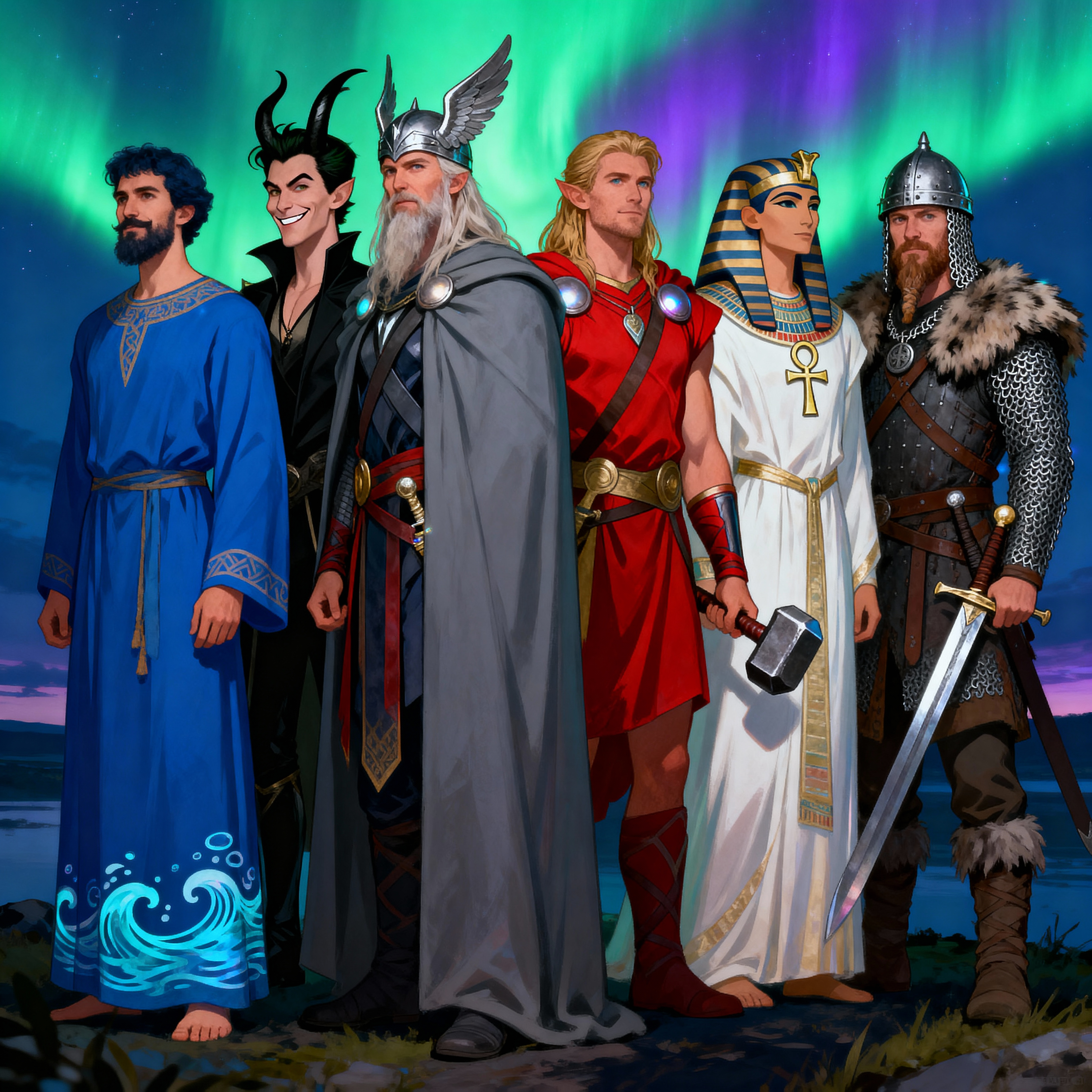

Beneath the aurora-lit sky of the far North, three divine figures stand united in strength and mystery. Odin, the All-Father, radiates wisdom and command, his presence rooted in timeless power. To his left, Thor exudes the force of thunder and courage, his stance protective and resolute. To his right, Loki’s calm intensity reflects cunning intellect and shadowed insight. Together, they form the trinity of mind, might, and mystery — the embodiment of cosmic balance between creation, preservation, and transformation. This moment captures the essence of the divine brotherhood that shaped both Asgard and Earth — the eternal watchers of the North.
🖼️ ROLLO OF NORMANDY — FROM RAIDER TO RULER

While Ragnar’s sons carved kingdoms in England, another Norse chieftain turned ambition into empire. Rollo, towering and indomitable, began as an unsuccessful sea raider upon the coasts of France. But in 886 CE, his fleet surrounded Paris. The French King, Charles the Simple, weary of war, offered silver and peace. Rollo accepted, but not as tribute—as territory.
In 911 CE, Rollo had himself baptized and married to Charles’s daughter Gisela. Charles gave Rollo the lands that would bear his people’s name: Normandy, the “Land of the Northmen.” Here, the Norse returned to being builders and farmers. They raised churches where mead-halls once stood and forged a new identity—the Normans. Rollo ruled until his death around 930 CE, and his line endured for centuries.
From his seed came William the Conqueror, who in 1066 CE crossed the Channel and seized England—fulfilling the destiny of the Northmen begun two centuries before.
CANUTE: THE VIKING KING OF ENGLAND
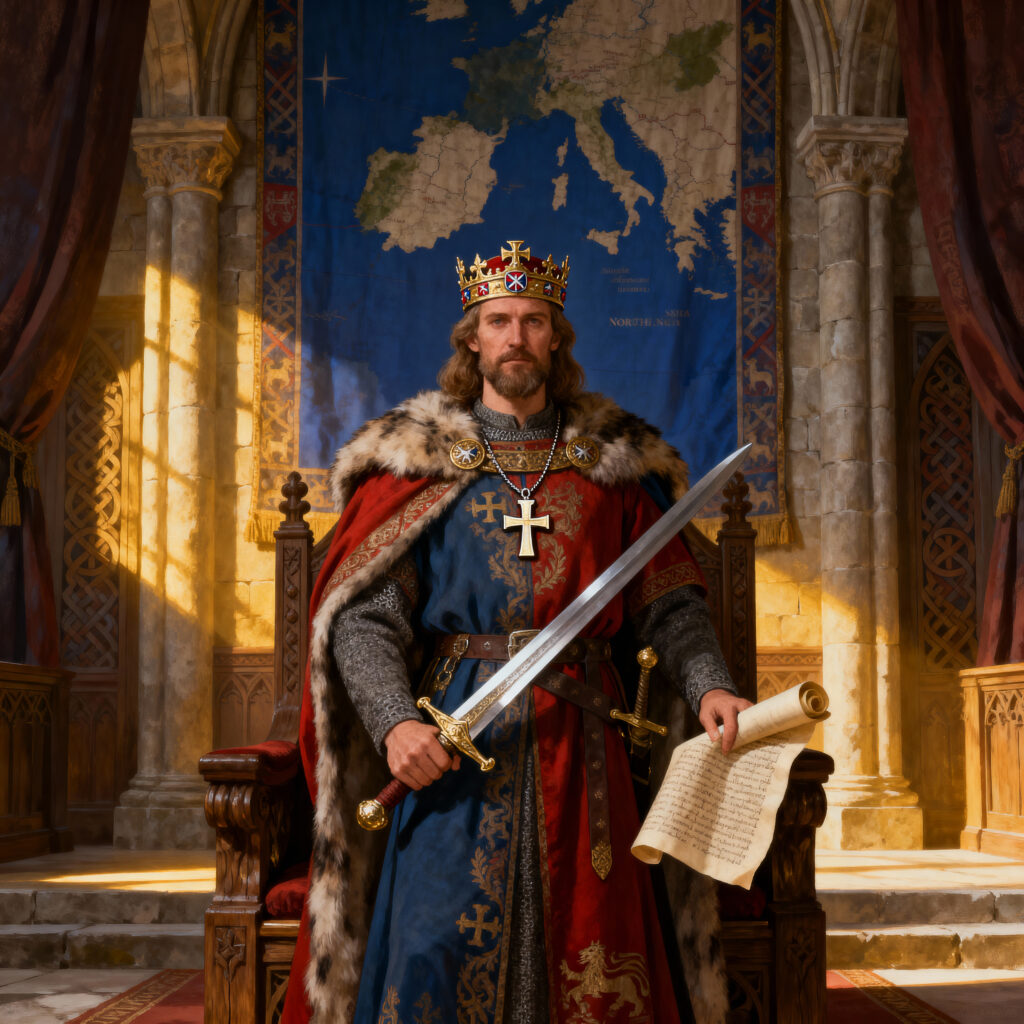
Beneath a golden sunrise, King Canute stands upon the English shore, cloaked in royal crimson and crowned in gold. His hand is raised toward the tide—not in arrogance, but in wisdom—commanding the sea to remind his court that even kings bow to higher powers. Behind him, the banners of Denmark and England ripple together in the morning wind, symbolizing unity and peace. The calm waters at his feet reflect both his image and his legacy: a ruler who bridged nations through strength, order, and faith.
Canute (Cnut) the Great, son of Swein Forkbeard, conquered England in 1016 CE, uniting it with Denmark and Norway into a single North Sea Empire. Canute governed with law and order, blending Norse valor with Saxon stability. He embraced Christianity. Under him, England knew peace.
HARALD HARDRADA: THE LAST VIKING KING

Beneath a storm-dark sky, Harald Hardrada stands upon a battlefield strewn with shields and banners. His armor glints with the last light of a fading sun, and a raven circles overhead — omen of Odin’s gaze. Once a Varangian guard and now a king, Harald embodies the final blaze of Viking glory: a warrior, exile, and ruler whose destiny spanned continents. Behind him, the mists of England rise as prophecy closes — for when the arrow strikes his throat at Stamford Bridge, the Viking Age itself falls silent.
Born of royal blood in 1015, Harald Hardrada lived a saga greater than any skald could sing. Warrior at fifteen, exile in Rus, commander of the Varangian Guard in Byzantium, husband to a Russian princess—Harald embodied the wanderer-warrior spirit of the North.
Harald returned to Norway, seized its throne, and ruled with iron discipline. He invaded England in 1066 and fought another King Harold—Harold Godwinson—at Stamford Bridge. Harold the Viking died there when an arrow pierced his throat. Thus ended the Viking era.
🜂 WILLIAM THE CONQUEROR — THE FULFILLMENT OF THE NORTHERN DESTINY

William stands upon the misty shores of England, the dawn of a new era breaking behind him. His sword gleams in the rising sun as he gazes toward the land he has claimed — the culmination of a lineage that began with Rollo and the Northmen. Ravens circle in the sky, heralding divine sanction, while his soldiers raise banners of red and gold, their armor catching the morning light. The Norman fleet glints upon the water, a fleet of destiny fulfilling the pact of gods and men. This moment marks the turning of an age — when Viking fire and Saxon strength fused into a single empire, and the legacy of the Anunnaki found form once more in mortal history.
When Rollo, the Viking chieftain, accepted Normandy from the Frankish king in 911 CE, he planted more than a flag — he seeded a destiny. His descendants, fierce and disciplined, merged Norse vigor with French refinement, becoming the Normans (“Northmen”).
From this bloodline rose William, Duke of Normandy, the great-grandson of Rollo. In 1066 CE, guided by unshakable purpose and perhaps ancestral prophecy, he crossed the English Channel with an army forged in the Northern spirit. At the Battle of Hastings, William defeated King Harold Godwinson — the same line that had slain Harald Hardrada earlier that year — thus uniting the fractured threads of Viking and Saxon fate.

William ruled as both conqueror and reformer, establishing law, order, and architecture in England. Under his reign, castles rose like stone runes upon the land, marking the dawn of the Norman age — an age that carried within it the echoes of Odin’s ambition and Enki’s design.
In the Anunnaki framework, William embodies the manifest will of the divine masculine: decisive, strategic, and transformational. He completed what Rollo began — the integration of the Norse and Saxon worlds — and set the stage for a new empire built upon order, intellect, and the seed of ancient celestial legacy.
BIOGRAPHY
Name: William I of England (William the Conqueror, Guillaume le Bâtard)
Born: 1028 CE, Falaise, Normandy
Died: 1087 CE, Rouen, France
Titles: Duke of Normandy (1035–1087), King of England (1066–1087)
Parents: Robert I, Duke of Normandy, and Herleva of Falaise
Known for: The Norman Conquest of England (1066 CE), establishing the Anglo-Norman dynasty, commissioning the Domesday Book, and introducing French culture, architecture, and governance to England.
Legacy: William united the Viking blood of the North with the administrative genius of the Latins. His lineage would rule England for centuries, spreading its influence across Europe — fulfilling what the Anunnaki might have called the Northern Mandate.
🎨 IMAGE — WILLIAM THE CONQUEROR: THE NORTHERN DESTINY FULFILLED
Description:
William stands upon the shores of England, his army behind him, and the Norman fleet glinting in the dawn light. He raises his sword toward the rising sun, a golden cross etched upon his armor, while ravens circle overhead — Odin’s blessing carried through blood and time. The battlefield of Hastings stretches behind him, the smoke of conquest mingling with the light of destiny.
Prompt:
Realistic cinematic painting of William the Conqueror standing on the English shore after victory at Hastings, 1066. Norman fleet in the distance, soldiers bearing banners of red and gold. William in chainmail and royal cloak, sword raised toward sunrise—ravens overhead symbolizing divine lineage; golden light breaking through clouds; mythic realism; landscape mode.
GROUP PORTRAITS & CAST CLOSEUPS
- THE ANUNNAKI OF THE NORTH — GROUP PORTRAIT (MEN)
Enki, Odin, Thor, Thoth, Loki, Ragnar, Harald Hardrada — standing together under the aurora, faces visible.


- THE GODDESSES OF THE NORTH — GROUP PORTRAIT (WOMEN)
Ninmah, Freyja, Lagertha, and Shieldmaidens — strong, serene, compassionate energy, faces clear and radiant.

- THE DIVINE COUNCIL OF THE NORTH — MIXED GROUP
Enki, Ninmah, Thoth, Odin, Freyja, Thor — gathered around a glowing table or portal with auroral light behind them, showing unity of masculine and feminine, logic and love.

THE CONCLAVE OF THE GODS AND KINGS


Under the shimmering auroras of the North, gods and mortals gather in luminous unity. Odin stands at the center, flanked by Enki’s wisdom, Thor’s valor, Freyja’s grace, and Ninmah’s compassion. Behind them, the kings of men — Canute, Harald Hardrada, and William the Conqueror — stand in reverent alliance. The aurora’s light weaves through their faces like divine thread, binding heaven and Earth in one eternal covenant.

The Conclave of the Gods and Kings gathered beneath glowing auroras. Enki, Ninmah, Thor, Thoth, Odin, Freyja, Canute, Harald Hardrada, and William the Conqueror stand in a circle, illuminated by celestial light: mythic realism, clear faces, northern plateau with ancient stones and mist, cosmic unity atmosphere.

THE MEN OF THE NORTH
Facial portraits of Enki, Odin, Thor, Thoth, and Loki — distinct personalities, intelligence, and strength.


- CLOSEUP: THE WOMEN OF THE NORTH
Ninmah, Freyja, Lagertha, and one Shieldmaiden — emotional focus on eyes and expression of compassion, wisdom, and courage.
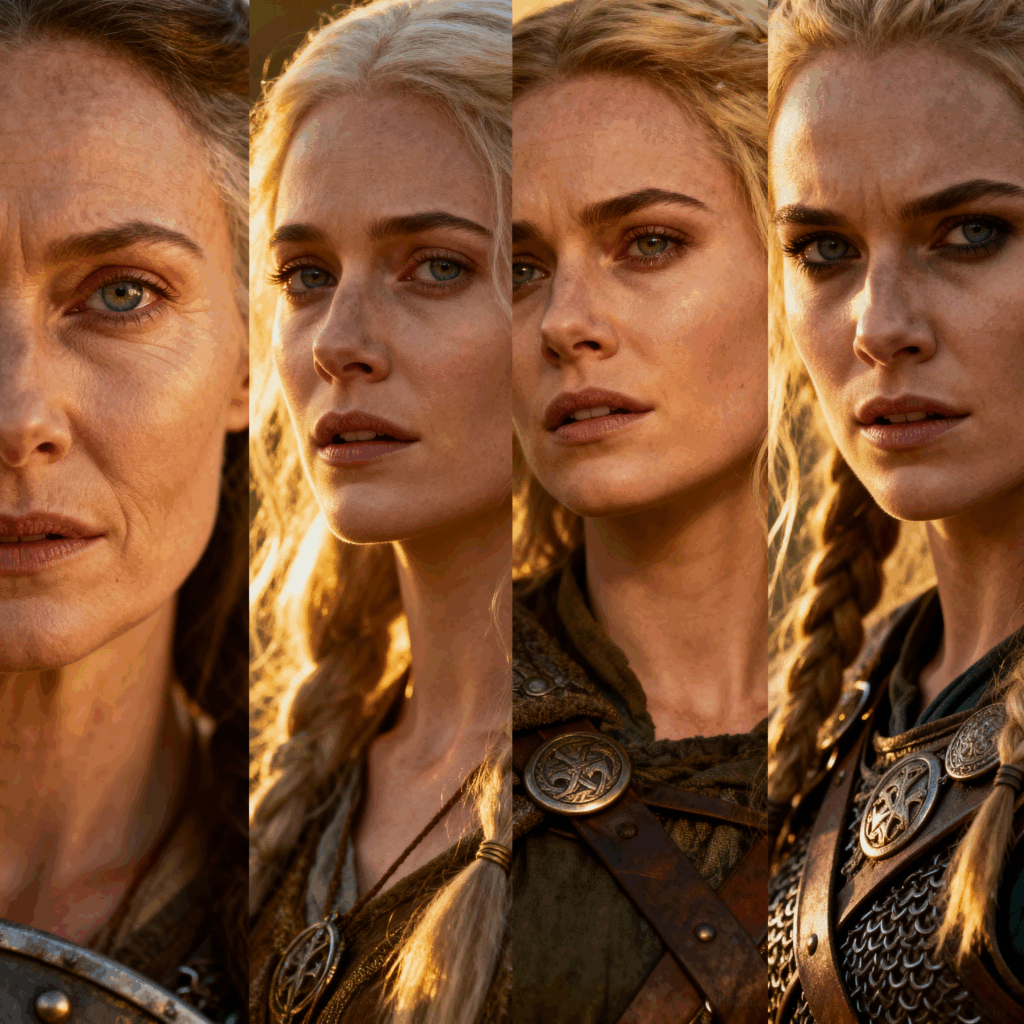
- CLOSEUP: THE DIVINE PARTNERSHIP — ENKI AND NINMAH
Warm lighting, love and understanding between them — subtle smile, shared gaze, aurora behind them.

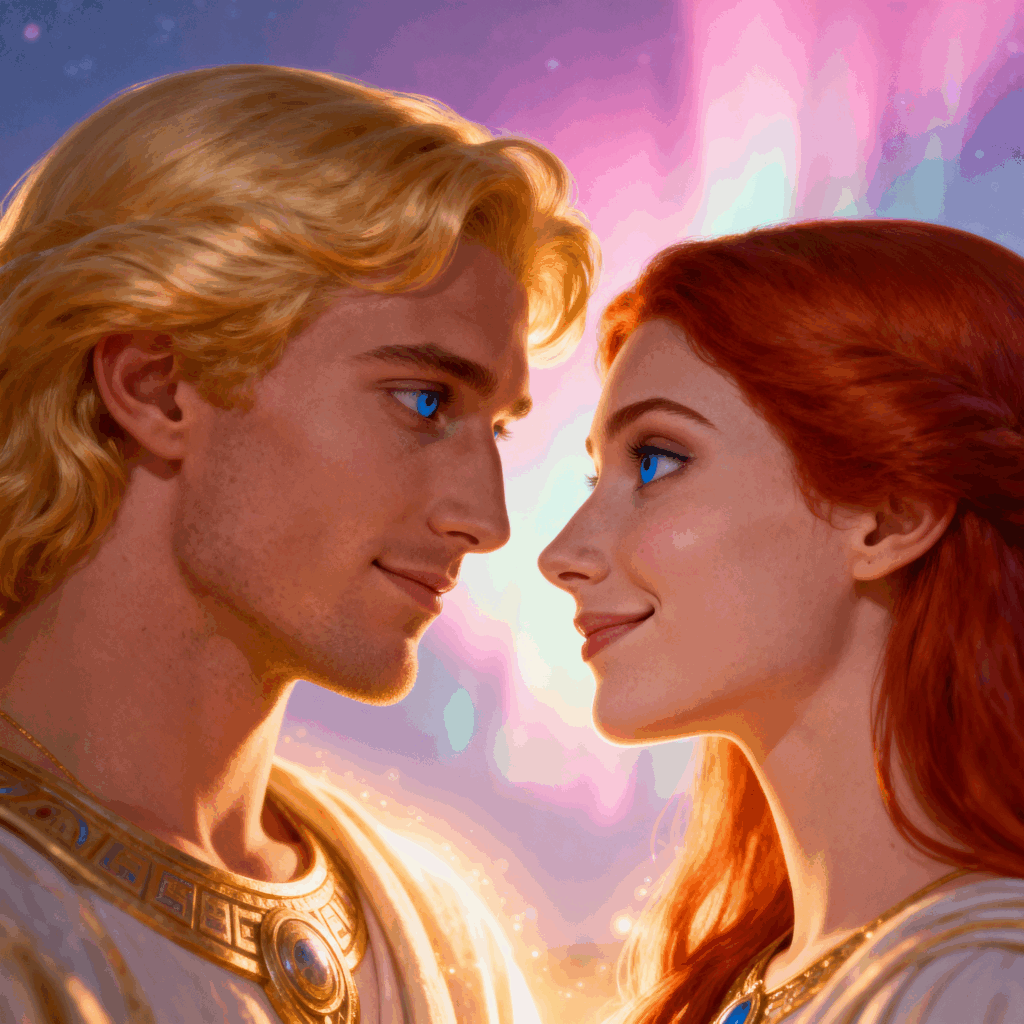

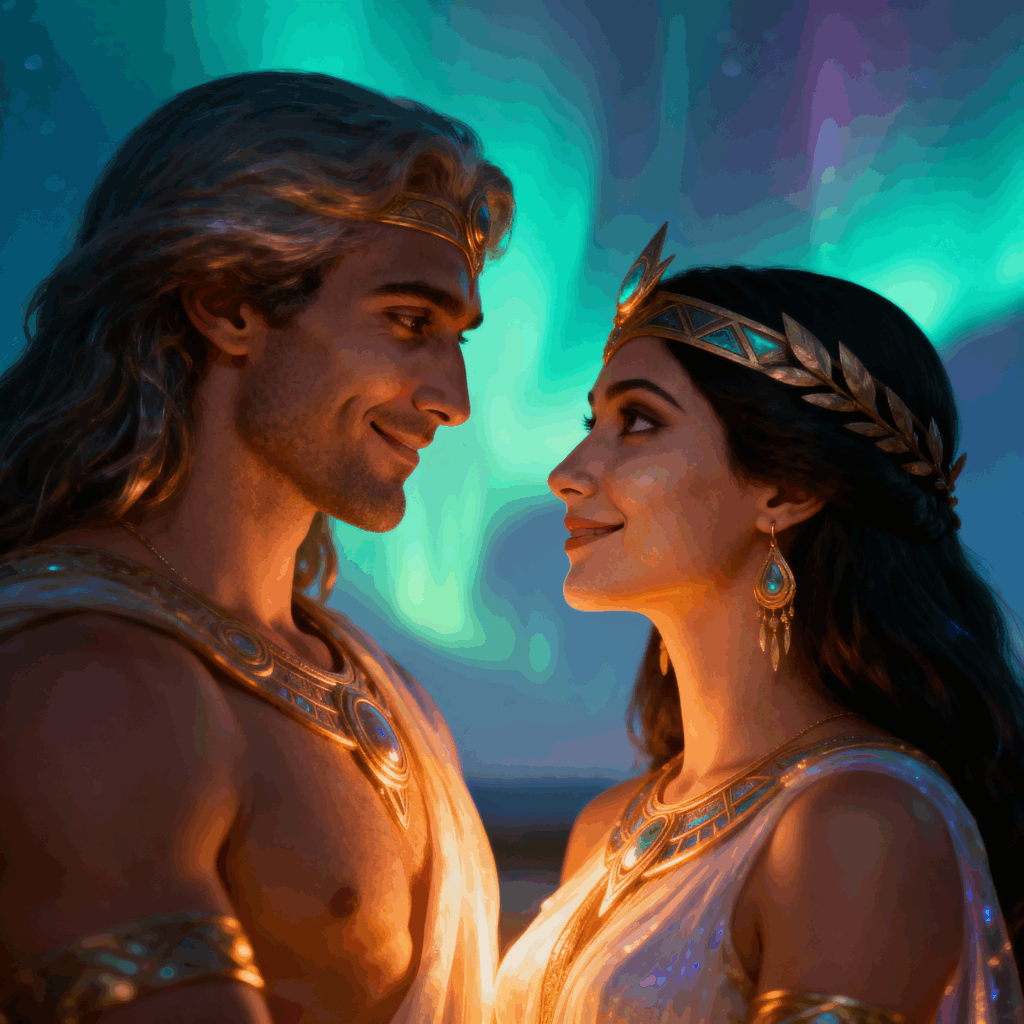

C. OPTIONAL EXPANSION IMAGES (FOR BOOK / SUBSTACK SERIES)
- VALHALLA AND NIBIRU — TWO WORLDS, ONE KINGDOM
Cosmic twin planets connected by a rainbow energy bridge.

- YGGDRASIL AND THE ABZU — THE TREE AND THE DEEP
Tree of life whose roots intertwine with flowing water and crystalline structures — a symbol of connection.

#Vikings #Anunnaki #Odin #Enki #NorseMythology #RagnarLodbrok #Lagertha #Valhalla #Nibiru #AncientAliens #AncientGods #AnunnakiHistory #PartnershipConsciousness #SpiritualEvolution #AncientAstronautTheory #EnkiSpeaks #AquarianMedia #SashaLessin #JanetKiraLessin #CosmicOrigins #WarriorSpirit #HistoryRevealed
Shieldmaidens

Women warriors in shining armor form a shield wall; Freyja’s energy glows behind them like a crimson aurora.
Yet the spirit of the Vikings was not solely male. Among them, women fought. Shieldmaidens, trained in arms, stood beside their brothers on the shield-wall, wielding axes and spears, dying with the same fearless gaze. They were daughters of Freyja-Inanna, embodiments of partnership and strength, guardians of the balance between creation and destruction. In their courage, the essence of the Partnership Consciousness that once guided Enki-Odin’s lineage lived on—respect between male and female, mortal and divine. That consciousness flickered amid the flames of conquest, dimmed but not extinguished.
Through storm and sword, the Northmen carried that spark across the world. And perhaps, in some distant age, their descendants—ours—will once more sail not the seas, but the stars, answering the same call that drew their ancestors from Asgard and Nibiru alike.
⚡ Who Was Odin — Anu or Enki? The Northern Mirror of the Anunnaki

Odin and Enki stand as reflections of one divine archetype — the wise wanderer who bridges worlds. Across the aurora-lit sky, the All-Father gazes toward the ships of humanity, while Enki’s luminous form mirrors him through a veil of starlight. The scene captures the moment of divine duality — the same consciousness expressed in different lands and languages, watching over the dawn of the North.
Across ages and continents, the same celestial family has worn many names. The Sumerians called them the Anunnaki, the Egyptians the Netjeru, and the Norse the Æsir. When their stories migrated northward through ages of human retelling and selective memory, the divine archetypes split and recombined, creating overlapping identities.

Beneath the shimmering aurora, Enki and Odin stand face to face across a sacred pool of light — one in Sumerian robes, the other in fur and iron. Between them spirals a column of glowing runes and cuneiform, symbols of wisdom shared across civilizations. The pool reflects their union, showing that the gods of North and South, Heaven and Earth, are but mirrors of one divine lineage. In this moment, the waters of Nibiru and Asgard flow together, bridging myth and memory through the language of light.
At the heart of this question stands Odin — the one-eyed All-Father, seeker of wisdom, wanderer between realms. But who is he in the Anunnaki lineage?
🜃 VERSION ONE — ODIN AS ANU: THE SKY FATHER

Odin sits enthroned beneath radiant golden light, his eyes filled with ancient wisdom and calm authority. His ravens, Huginn and Muninn, rest beside him, whispering thoughts and memories gathered from across the realms. Behind him, Thor stands resolute, hammer in hand, while Loki lingers in the shadows — the balance of power and cunning embodied. The halo behind Odin’s head evokes Anu’s celestial throne upon Nibiru, symbolizing divine governance and cosmic order.
In this interpretation, Odin corresponds to Anu, the High King of Heaven, ruler of the Great Council, and patriarch of the divine family.
- Odin’s throne, Hlidskjalf, from which he can see all worlds, mirrors Anu’s seat upon the throne of Nibiru, overseeing gods and men alike.
- The ravens Huginn and Muninn (“Thought” and “Memory”) parallel Anu’s two spiritual messengers or watchers, known in Sumerian tradition as emissaries who gather intelligence across realms.
- His sons, Thor and Loki, represent the polar duality of his offspring — Enlil and Enki — both born of divine union yet forever at odds in purpose.

Odin, majestic and radiant, sits upon a golden throne that glows with celestial fire. His ravens, Huginn and Muninn, perch upon his arms as living symbols of divine thought and memory. Thor stands at his left, a pillar of thunder and law, while Loki watches from his right, the embodiment of cunning and transformation. The throne room unites Norse grandeur with Sumerian elegance — hieroglyphs, runes, and winged motifs carved into golden stone — reflecting Anu’s dominion over both gods and men.
In this version, Thor embodies Enlil’s force and discipline — thunder, law, and divine authority — while Loki mirrors Enki’s cunning, creativity, and rebellion. Odin (Anu) stands above them as the great balancer of cosmic tension.
This reading places Odin-Anu as the eternal patriarch, father of order and judgment, the architect of hierarchy itself.
🌊 VERSION TWO — ODIN AS ENKI: THE WANDERING LORD OF WISDOM
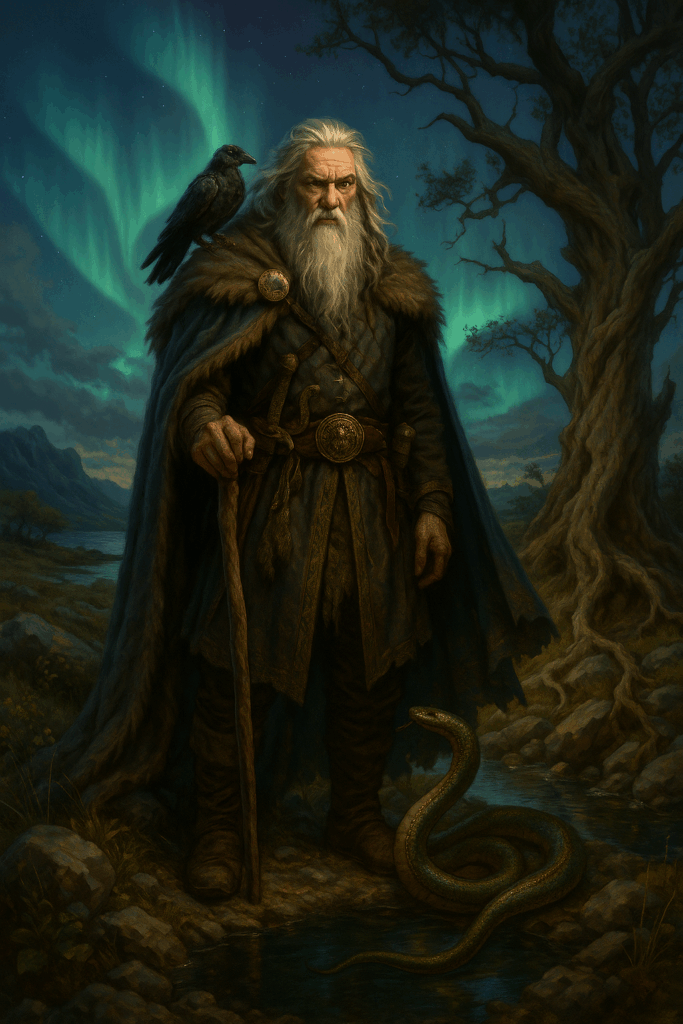
In this vision, Odin appears as Enki — serene, compassionate, and surrounded by the sacred waters of creation. Beneath the aurora, he stands beside a shining pool that mirrors the stars above, symbolizing the Abzu — the deep well of divine knowledge. His cloak blends Norse runes and Sumerian water glyphs, representing the union of two wisdom traditions. A great serpent coils protectively within the reflection, while glowing cuneiform and runes intertwine in the air like living light. In the distance, Thor (as Marduk/Ninurta) wields his hammer upon a mountain ridge, and Loki (as Thoth/Ningishzidda) holds a luminous staff of science and magic — sons continuing their father’s legacy of balance and creation.

Odin sits enthroned high beneath the aurora, his golden crown gleaming in the starlit night. Ravens perch beside him—Huginn and Muninn—guardians of wisdom and memory. At his side stand Thor, the thunder-wielder, and Loki, the cunning flame, each reflecting divine polarity. From Hlidskjalf, Odin gazes upon all realms, mirroring Anu upon the throne of Nibiru—the cosmic patriarch overseeing gods and men alike.
The second interpretation — and the one that resonates most through heart and myth — casts Odin as Enki.
- Both are seekers of forbidden knowledge who sacrifice themselves for wisdom: Odin hanging on Yggdrasil to gain the runes, Enki defying decrees to save humankind.
- Both embody compassion and cleverness rather than domination. They prefer teaching and weaving destiny to enforcing law.
- Odin’s association with ravens, serpents, and wells (the Well of Mimir, the serpent Jörmungandr) all echo Enki’s symbols of water, serpentine wisdom, and the Abzu (the deep waters of creation).
- Odin’s wanderings through Midgard parallel Enki’s earthly incarnations — guiding kings, shamans, and builders across the ages.

Beneath the shimmering aurora, Odin stands revealed as Enki — the master of knowledge and the waters of creation. His robes shimmer with both Norse runes and Sumerian cuneiform, uniting two civilizations under the same cosmic truth. A glowing serpent ripples across the sacred pool, symbolizing divine wisdom and eternal renewal. Behind him, Thor and Loki emerge from the mist, the sons of power and mystery, guided by their father’s ancient light. Circles of radiant runes spiral above Odin’s head, echoing the Abzu and the celestial geometry of Nibiru itself.
In this lineage, Thor emerges as Marduk or Ninurta, the warrior son who inherits his father’s power but uses it to shape worlds. Meanwhile, Loki becomes Thoth/Ningishzidda, the trickster-intellect whose dual nature bridges light and shadow, magic and science. The connection between Thoth and Thor—their shared phonetics and elemental roots (lightning, wisdom, language)—suggests that the Norse thunder god carries echoes of both the son’s and the scribe’s legacy: energy, articulation, and law combined.
🌌 VERSION THREE — THE LAYERED ARCHETYPE: BOTH AT ONCE
🜄 VERSION THREE — ODIN AS THE COMPOSITE: THE BRIDGE BETWEEN HEAVEN AND EARTH
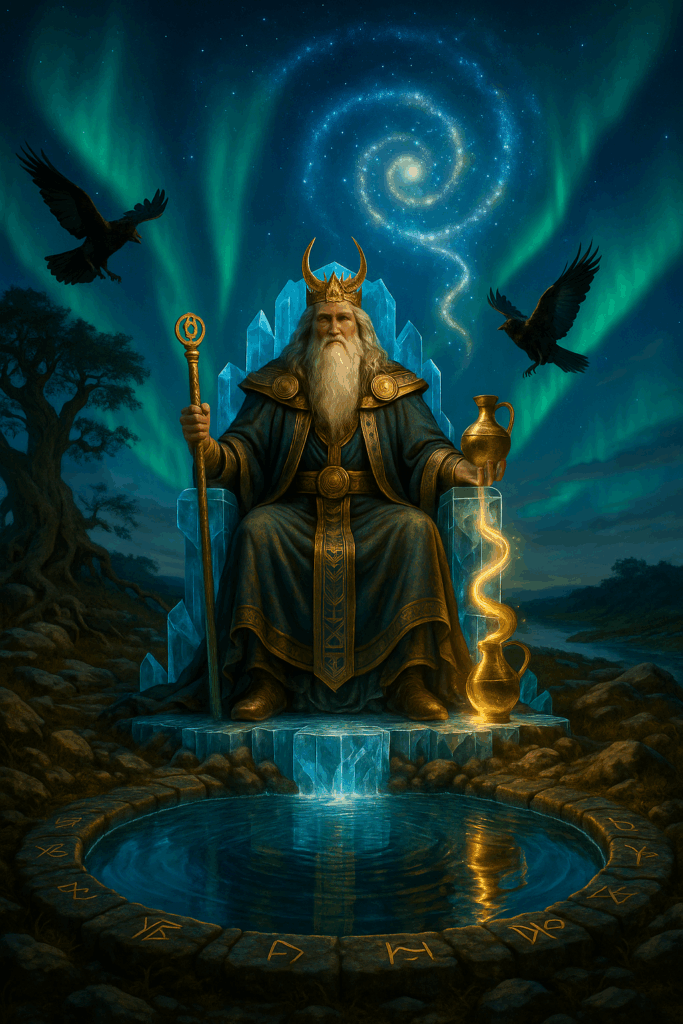
In this vision, Odin stands at the axis of creation — the union of Anu’s celestial authority and Enki’s living wisdom. Seated upon a crystalline throne that shimmers between light and water, he gazes across dimensions: Nibiru above, Midgard below. The aurora swirls around him like a living Bifröst, a conduit of plasma and consciousness linking gods and mortals.

One hand holds Anu’s golden scepter of command, radiating solar energy; the other, Enki’s vessel of flowing water, glowing with the light of life itself. Ravens circle in eternal orbit, while Yggdrasil’s roots and branches intertwine through the air, symbolizing the cosmic circuitry of creation. Odin’s eyes shine with the awareness of both father and son, judgment and mercy, heaven and Earth — a synthesis of divine polarity.

Thus, Odin is both Anu and Enki, depending on which current you follow:
- The celestial aspect (Sky Father) reflects Anu.
- The earthly and compassionate aspect (Wisdom Bearer) reflects Enki.
Together they form the complete archetype of the All-Father, the union of judgment and mercy, mind and heart.
🜂 THOTH AND THOR — THE DOUBLE LIGHTNING

Thoth, the Egyptian Lord of Divine Speech, and Thor, the Norse Master of Thunder, stand face to face beneath a storm-charged sky. A bolt of lightning connects their sacred instruments — Thoth’s staff crowned with the ankh and Thor’s mighty hammer, Mjölnir — symbolizing the convergence of sound and force, word and will. The ibis-headed god of wisdom radiates golden light, while Thor glows with blue-white fire. Between them, the heavens pulse with the current of creation itself — the living Word becoming form.
The similarity of their names is not a coincidence. Both derive from the root of Divine Speech — the Voice that commands creation.
- Thoth wields the Word, sacred language, and geometry.
- Thor wields the Hammer, the sound of thunder that shakes heaven and earth.

In spiritual physics, these are twin expressions of the same current — one mental, one electrical. Both shape the universe through vibration and resonance. Thus, Thor can be read as the embodied form of Thoth’s energy — thunder made flesh, wisdom made motion. When Marduk, Ninurta, or Thoth act through the northern lineage, they appear as Thor: the defender, the purifier, the storm that clears the air for renewal.
🜁 NINMAH — THE NORTH’S HIDDEN QUEEN

🜁 NINMAH — THE NORTH’S HIDDEN QUEEN
In the twilight of the North, beneath curtains of emerald light, stands Ninmah — the eternal Mother of Life, known to the Norse as Freyja. Draped in a silver-blue gown woven with sacred runes and Sumerian sigils, she radiates both wisdom and warmth, embodying the fusion of heaven’s intellect and Earth’s compassion.

Amber tears fall from her hands, glowing with the memory of humanity’s creation and her sorrow after the Deluge. Each drop becomes a seed of renewal — the golden essence that rekindled life upon the frozen Earth. Around her, the aurora dances like the breath of the gods, while the wildflowers of the North bloom in her presence.
Here, Ninmah is not a forgotten goddess but the living heart of the divine partnership — the mother of balance, the keeper of life, and the bridge between the Anunnaki and humankind.

If Odin represents Enki’s divine mind, and Thor/Thoth represents his creative energy, then Ninmah lives through Freyja, the goddess of beauty, fertility, and magic. She is the keeper of balance—the heart within the storm, the memory of the sacred partnership between the gods and humankind.
Her tears of amber in Norse myth echo Ninmah’s sorrow for humanity after the Deluge—a love so deep it continues to pulse in every story of the Mother Goddess.

🕊️ The Continuum Reaffirmed
So, who was Odin? The answer is yes.
He was Anu in heaven, Enki on Earth, and the reflection of both in myth.
Thor, Loki, and Thoth are the next spirals of that same fractal pattern, each carrying divine purpose through time.
The gods never vanished—they changed their names, their languages, their costumes. But their essence endures, guiding humanity’s remembrance of its own divine origins.
⚖️ ODIN’S LINEAGE: TWO ANUNNAKI MODELS

The question of Odin’s true counterpart among the Anunnaki remains one of the most intriguing puzzles in comparative theology. Was the All-Father the elder sky-king Anu himself—or was he Enki, the wise water-lord who guided humanity through ages of darkness?
Both interpretations carry weight, and both illuminate different aspects of Norse cosmology.
In the first model, Anu, as Odin, the All-Father, is the distant patriarch ruling from the heavens, his sons, Enlil (Thor) and Enki (Loki), carrying out the works of storm and craft below. This echoes the old Sumerian trinity—Anu, Enlil, and Enki—translated into the language of the North: sky-father, thunderer, and trickster.

Beneath the shimmering auroras of the northern sky, three radiant beings stand upon the living Earth — the ancient trinity reborn through the myths of the North. At the center, the crowned All-Father radiates golden authority, symbol of the divine order that sustains worlds. To his right, the lightning-bearing warrior glows with the fire of creation and protection; to his left, the sage of green light channels the wisdom of the deep, his hands weaving currents of life and magic. Above them, Yggdrasil — the World Tree — unfurls its branches across the heavens, its crown encircled by luminous runes and cuneiform alike, uniting Norse and Sumerian cosmologies in one timeless vision. This is the moment when sky, storm, and sea — Anu, Enlil, and Enki — converge as one divine consciousness guiding Earth’s evolution.
Yet another thread runs through the sagas. Here, Enki becomes Odin, the wandering god of wisdom who sacrifices himself upon the World Tree for the sake of knowledge. This mirrors Enki’s continual pattern—descending into the depths to bring light to humankind. If Enki is Odin, then Marduk becomes Thor, the impulsive son who wields the weapon of power. At the same time, Thoth (Ningishzidda) takes the role of Loki, the shapeshifting intellect whose mischief often hides higher intent.

These dual interpretations are not contradictions but layers—different lenses through which the same celestial lineage is remembered. In one, Odin is the sovereign who governs from the stars; in the other, he is the mentor who walks among men. Both speak of divine continuity—the Anunnaki never left; they changed names and continents.
Whether Anu or Enki, the All-Father remains the bearer of order amid chaos. His wisdom flows through generations, from Sumer to Scandinavia, like the waters of life that never cease to return to their source.
✦ Analytical Outline
| MODEL | ODIN | THOR | LOKI | SUPPORTING NOTES |
|---|---|---|---|---|
| Model 1: Odin = Anu | Supreme Sky Father, remote yet commanding | Enlil – Storm God, wielder of thunder, disciplined force | Enki – Trickster / Innovator / Rebellious savior | Mirrors the traditional Sumerian triad; fits the patriarchal structure remembered by later myth. |
| Model 2: Odin = Enki | Wise wanderer, giver of knowledge, master of runes (DNA codes) | Marduk – Son of Enki, strong but rash; mirrors Thor’s temper | Thoth (Ningishzidda) – Loki, shapeshifter, scientist, consciousness trickster | Fits the esoteric current emphasizing wisdom, compassion, and creative rebellion. |
| Interpretive bridge | Both models reveal one truth: The Norse gods preserve the memory of Sumerian ancestry in northern form. “Odin” is a title, not a single being. The mantle of All-Father passes between Anu and Enki across ages. |
🜂 ASGARD AND VALHALLA — ECHOES OF NIBIRU
The ancients spoke of Asgard as a realm above the Earth, reachable only by crossing the Bifröst—the rainbow bridge of shimmering light that linked heaven and humanity. Yet what if this bridge was not a poetic metaphor, but a literal pathway—an arc of plasma or electromagnetic energy connecting two worlds?

ASGARD AND NIBIRU — BRIDGE BETWEEN WORLDS
A rainbow-like aurora bridge connecting Earth to a glowing planet or orbital city; divine light radiates between realms.
In the Anunnaki framework, Asgard mirrors Nibiru: both are the dwelling places of the gods, orbiting beyond the reach of ordinary mortals, both accessible only through flight or vibration. Their luminous cities, golden towers, and sky-bridges may be encrypted descriptions of what once existed—orbital sanctuaries, star stations, or vast moving planet-ships from which the divine overseers of Earth watched over their creation.
The Bifröst, in this sense, becomes not myth but memory—a remembrance of the energy conduits and flight corridors once used by Enki, Ninmah, and Thoth to travel between Earth and the heavens. These were not “gods” in the primitive sense, but the master scientists and engineers of a civilization so advanced that to early humanity, they appeared divine.
In the cosmology of the Anunnaki, Nibiru was the original Asgard: a living world that carried the royal line of Anu, Enki, and Ninmah. When Earth entered instability—through floods, pole shifts, or wars among the gods—they retreated to Nibiru, yet kept connection through portals and command grids. Those grids were later remembered in human tradition as the Bifröst bridge, the “shining road of the gods.”
VALHALLA — THE HALL OF THE CHOSEN WARRIORS

In Norse cosmology, Valhalla is the great golden hall of the slain, located in Asgard and presided over by Odin. Warriors who die bravely in battle — chosen by the Valkyries — enter Valhalla to join the ranks of the Einherjar. Within its shield-roofed halls, they feast, fight, and prepare for the final cosmic war, Ragnarok. Encyclopedia Britannica+2Battle-Merchant ⚔+2
In the framework of the Anunnaki–Norse synthesis, Valhalla may represent not merely the afterlife but a celestial station or transition hub — a divine realm where selected souls or initiates join the gods, where honor and partnership with the divine continue in orbit or in another dimension.
NIBIRU — THE HOMEWORLD OF THE GODS

Nibiru, in the Anunnaki tradition, is the royal planet-ship or world associated with the gods — especially Anu and his divine family. Some Sumerian texts link the term with a “crossing place” or “place of transition.” In the Norse-Anunnaki narrative, Nibiru parallels Asgard — the celestial dwelling of the divine line — reinforcing the theme that the gods’ home lies beyond mid-earth, accessible via plasma bridges such as the Bifröst.
ASGARD — THE REALM ABOVE WORLDS

Asgard is the exalted dwelling-place of the Aesir gods in Norse cosmology — the cosmic citadel perched among the highest branches of the world-tree Yggdrasil, connected to the human realm (Midgard) by the luminous bridge Bifröst. Mythopedia The term itself derives from Old Norse Ásgarðr, meaning “enclosure of the gods”, combining áss (god) and garðr (enclosure/wall). Norse Mythology for Smart People+1

Mythic texts depict Asgard as a grand, fortress-like place with golden halls, awe-inspiring architecture, and a protective wall guarding the divine order from chaos. In the Anunnaki-Norse synthesis, Asgard is not simply myth but a memory of a celestial station — a realm orbiting or perched beyond our atmosphere, where gods and chosen souls convened, and from where the rainbow bridge was more than allegory.
THE HALLS OF VALHALLA — TEMPLE OF THE GODS

Inside a radiant hall of gold and crystal, figures resembling Enki, Ninmah, and Odin converse. The walls reflect constellations and portals, showing both Earth and Nibiru through luminous windows.
Valhalla, too, reveals its hidden lineage. Far from being a simple hall of the dead, it may represent a celestial transfer station, a sanctuary aboard that orbiting realm where the most evolved souls—those who had “died well”—were invited to continue their growth. To “ride to Valhalla” was to ascend, to be chosen for the next level of consciousness, much as Enki and Ninmah once elevated select humans into higher understanding and even hybrid immortality.

A radiant golden hall filled with celestial light; Enki, Ninmah, and Odin stand near a great window showing both Earth and Nibiru.
Seen through this lens, Asgard and Valhalla were not ethereal heavens but dimensional outposts that existed simultaneously in both the physical and spiritual planes. They were both sanctuary and school—stations for travelers between worlds. When the Anunnaki withdrew to Nibiru and beyond, they left behind a blueprint of that higher order encoded in humanity’s memory.
Thus the Norse remembered, in their sagas and songs, what the Sumerians had recorded in their tablets: a divine family who ruled from the heavens, guided by wisdom, and whose legacy endures in the geometry of our myths, the alignments of our monuments, and the longings of our souls.
Asgard and Nibiru are, in truth, two names for one enduring idea—the dwelling place of the gods, ever beyond reach yet never beyond remembrance.
What are the differences & similarities between Asgard, Nibiru, and Valhalla?
Asgard, Nibiru, and Valhalla represent three expressions of the same cosmic archetype seen through different cultural lenses. Let’s explore them clearly and comparatively:
🜂 ASGARD — THE CELESTIAL CITY OF THE ÆSIR
Nature: A dimensional or orbital realm, home of the gods (Æsir) in Norse cosmology.
Function: Seat of divine governance — where Odin, Frigg, Thor, and the others dwell, observe, and guide humanity.
Symbolism: Order, wisdom, and guardianship.
Access Point: Reached via the Bifröst, a rainbow-like energy bridge connecting Earth (Midgard) to the heavens.
Possible Parallel: The orbital or interdimensional command base from which the Anunnaki (or other celestial beings) once interacted with Earth.
Interpretation:
Asgard is not a “heaven” of the dead, but rather a realm of higher consciousness and technology — possibly a literal station or planetary base observed by ancient witnesses as glowing, radiant, and unreachable except by “flight.”
🜁 NIBIRU — THE ANUNNAKI HOMEWORLD

Nature: A planet or transdimensional world in Sumerian cosmology, described as the dwelling of Anu and the Anunnaki gods.
Function: Governing center of a galactic or solar confederation; origin point of the beings who came to Earth to engineer life and civilization.
Symbolism: Origins, authority, and celestial kingship.
Access Point: Astronomical or vibrational — “crossing point” (Nibiru literally means the crossing).
Possible Parallel: The source realm from which the Norse gods of Asgard may have descended.
Interpretation:
Nibiru may have been both a planet and a higher-frequency dimension. Its orbital-crossing stories could reflect the periodic appearance of the gods’ ships or their presence in Earth’s skies — later remembered as divine return cycles.
🜃 VALHALLA — THE HALL OF ASCENSION
Nature: A radiant hall within or beyond Asgard where chosen souls — the brave, wise, or awakened — are gathered.
Function: Transition realm; training ground for the next stage of being.
Symbolism: Initiation, renewal, and eternal life.
Access Point: Through valor, consciousness, or initiation rites; metaphorically, through spiritual readiness.
Possible Parallel: The heavenly chambers or energy sanctuaries described in Sumerian and Egyptian texts — ascension stations or healing temples aboard celestial craft.
Interpretation:
Valhalla may symbolize the soul’s transfer station — an intermediary realm where consciousness expands before returning to the physical world or moving on to higher planes.
⚖️ SHARED ESSENCE
| Aspect | Asgard | Nibiru | Valhalla |
|---|---|---|---|
| Realm Type | Celestial domain | Origin of the world of the gods | Spiritual hall within the celestial domain |
| Function | Home of the gods | Origin world of the gods | Place of initiation or ascension |
| Element | Air / Light | Ether / Fire | Light / Spirit |
| Core Symbol | Bridge (Bifröst) | Crossing (Nibiru) | Hall of Light |
| Archetypal Role | Governance | Origin | Renewal |
| Shared Meaning | All represent contact points between mortal and divine — stages of return to Source consciousness. |
✨ IN SUMMARY
All three describe different facets of the same cosmic geography:
- Nibiru is the origin — the home star or higher realm.
- Asgard is the embassy or outpost — the operational link between gods and Earth.
- Valhalla is the gateway of return — where enlightened souls prepare for higher service.
Together, they form a trinity of Origin, Connection, and Return — mirroring humanity’s spiritual journey.
🜂 FLIGHT OF THE GODS — LOGIC, LEGEND, AND THE SKY REALMS

🜂 THE FLIGHT OF THE GODS — LOGIC, LIGHT, AND THE RAINBOW PATH
This section weaves together logic and legend to explore how ancient cultures remembered celestial travel as a divine experience. It opens with a Spock-worthy inquiry into the rational mechanics of Asgard’s location — suggesting that the gods’ realm was literally off-world, accessible only by advanced flight or vibrational gateways.
The title reflects the balance of intellect and wonder — “Logic, Light, and the Rainbow Path” — uniting the Norse Bifröst and the Sumerian Dur. An.Ki (“Bond Heaven-Earth”) into a single cosmic architecture.
Here, the aurora becomes the physical residue of once-active plasma corridors, shimmering bridges once traversed by Enki, Ninmah, and Thoth — the engineers of the gods’ skycraft. The “Travelers of Light” image and subheading follow naturally here, offering a visual embodiment of this theme.
Through logic and reverence, this section reframes Asgard and Valhalla not as metaphors for the afterlife, but as outposts of higher consciousness — orbiting sanctuaries where spirit and science were one.

A luminous bridge of light arcs from Earth to the stars. A golden sky-ship glides along it, with faint silhouettes of Enki, Ninmah, and Thoth guiding the way — Norse runes and Sumerian symbols glowing together in the air.
If we apply logic — the kind that would make even Mr. Spock arch a Vulcan brow — then the simplest explanation for where the gods resided is also the most direct: you had to fly there to get there.
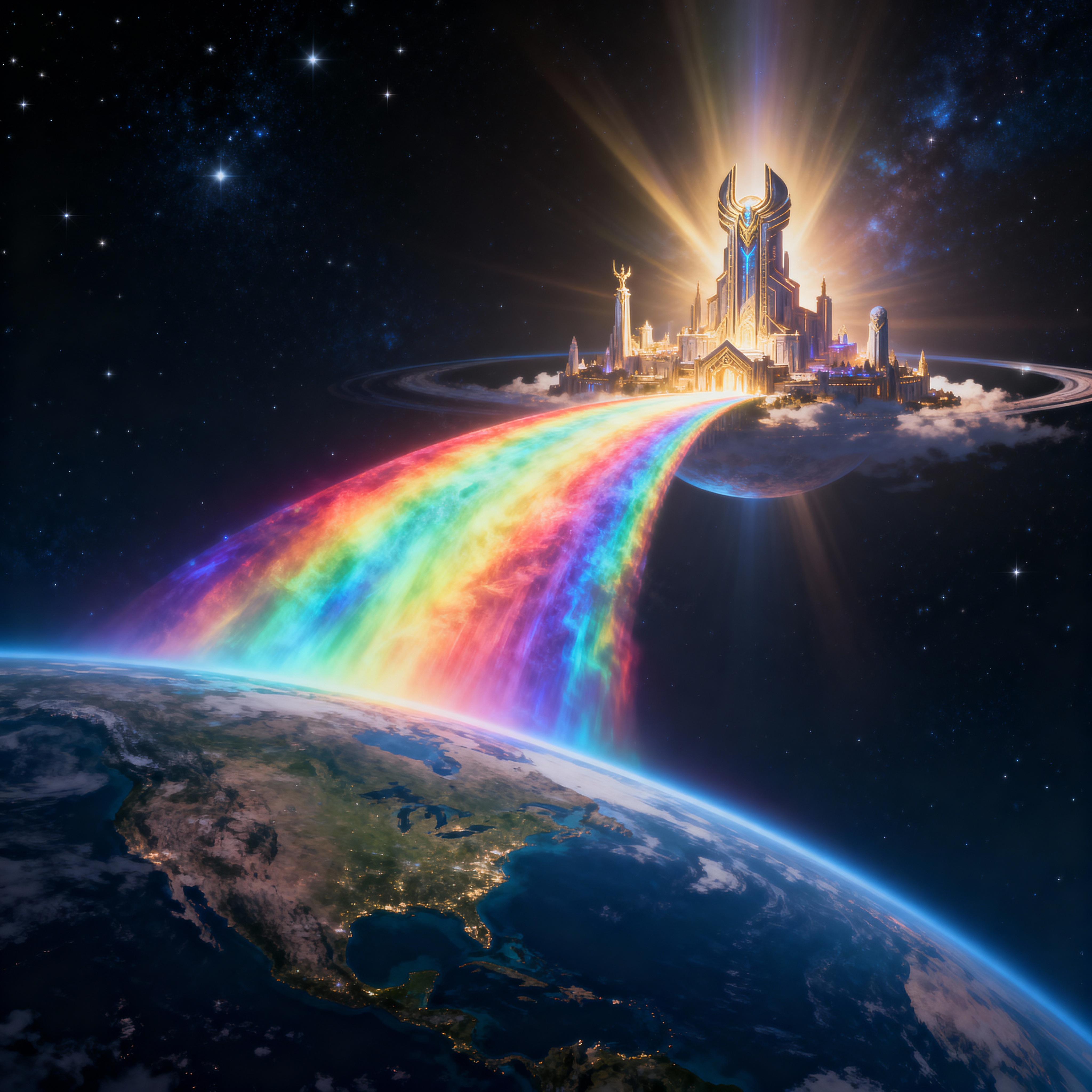
The ancient texts are explicit. Asgard was “above,” reached only by the Bifröst bridge, a shining arc that joined Earth and the heavens. The Norse poets described this bridge as radiant, vibrating, and alive with color—an image that mirrors the auroral bands and plasma arcs observed in high-altitude physics today. Could these stories be the cultural memory of advanced flight corridors, energy conduits, or interdimensional gateways once traversed by the Anunnaki?
From the Sumerian Dur. An.Ki — the “Bond Heaven-Earth” — to the Norse Bifröst, the concept of a sky bridge repeats across civilizations. Logic suggests that if the gods descended, they must have come from somewhere. And if Asgard and Valhalla were “beyond reach,” perhaps that meant beyond Earth — orbital, transdimensional, or even planetary, like Nibiru.
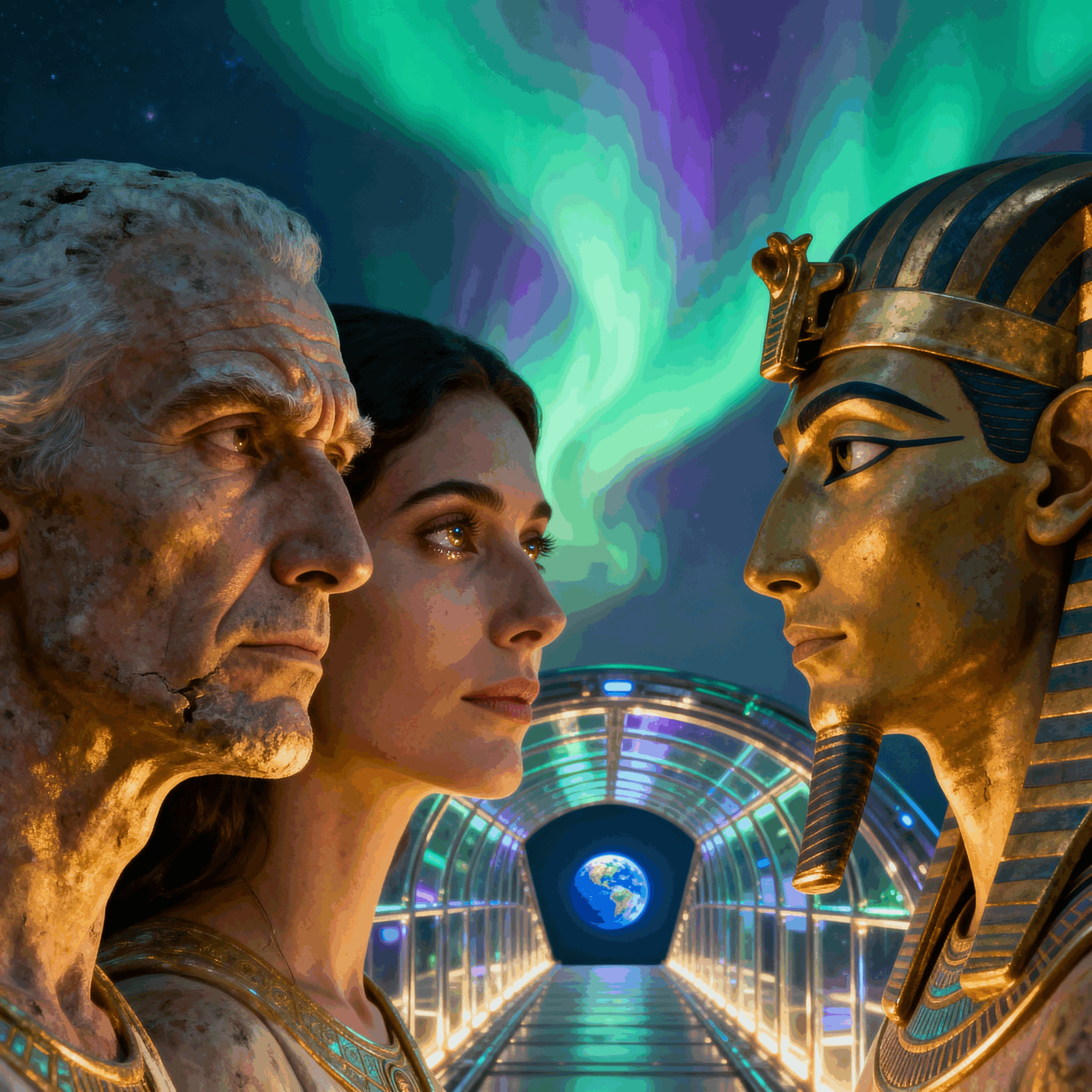
Close-up of Enki, Ninmah, and Thoth aboard the radiant bridge — faces illuminated by plasma glow, eyes filled with knowing compassion as they gaze toward Earth.
Seeing the old myths as navigational memory rather than mere allegory is not about abandoning reason but about applying it. As Spock says, “Logic is the beginning of wisdom, not the end.” When we lift the blinders of disbelief, Norse cosmology opens like a star map, its coordinates aligning not only with imagination but with spaceflight physics. In this view, Valhalla was not just a hall of the dead but a transfer station for the soul—a waypoint for ascension, a sanctuary in the sky. The chosen warriors, “those who die well,” might symbolize initiates ready for the next step of evolution, boarding the sky-ships that carry the worthy beyond Earth’s surface.
Asgard and Nibiru could then be two names for the same idea—the home of the divine family, beyond our atmosphere yet still within our ancestral memory. The rainbow bridge was no fantasy; it was a flight path, recorded in poetry so that later generations, who lacked the technology to visit the gods, would remember that such journeys once existed. And as we remember, Enki and Thoth were the engineers of flight—the designers of portals, grids, and vessels that could cross stars. Wherever Asgard truly is, its foundations were laid by minds who understood both science and spirit—who saw no division between logic and love.
In this light, Valhalla was not a hall of the dead, but a transfer station of the soul — a way-point for ascension, a sanctuary in the heavens. The chosen warriors, “those who die well,” may have symbolized initiates ready for the next stage of evolution, boarding the sky-ships that ferried the worthy beyond the Earth-plane.
Asgard and Nibiru, then, may be two names for the same idea — the dwelling place of the divine family, beyond our atmosphere yet still within our ancestral memory. The rainbow bridge was no fantasy; it was a flight path, recorded in poetry so that later generations, who no longer had the technology to visit the gods, would at least remember that such journeys were once possible.
And as we recall, Enki and Thoth were the engineers of flight — the architects of portals, grids, and vessels that could traverse the stars. Wherever Asgard truly lies, its foundations were laid by minds who understood both science and spirit — who saw no division between logic and love.
🜂 LOGICAL ANALYSIS: WHO IS ODIN — ANU OR ENKI?

Odin and Enki stand beneath the shimmering aurora, symbols of mind and water united in wisdom. Odin’s staff glows with runes of knowledge while Enki’s vessel radiates the light of creation. Between them, ancient Sumerian cuneiform and Norse runes swirl in a luminous spiral, representing their shared purpose: compassion through understanding. Behind them, Yggdrasil’s roots merge with the Abzu, forming the cosmic bridge that links heaven, Earth, and Nibiru — the eternal axis of divine intellect and love.
When we analyze the evidence through the lens of logic, Enki as Odin emerges as the more coherent model.
The parallels between the two are unmistakable. Both are wanderers of wisdom, seekers of knowledge who sacrifice comfort for enlightenment — Enki diving into the abyss to bring life to humanity, Odin hanging upon Yggdrasil to gain the runes of power. Both defy authoritarian decrees — Enki against Enlil’s rigid order, Odin against fate and prophecy itself — yet both act out of compassion for humankind.
The Anu = Odin hypothesis fits the hierarchical image of an All-Father enthroned in distant splendor, but it lacks the intimate, human connection that defines Odin’s presence in the sagas. Enki’s hands-on relationship with creation, his emotional depth, and his mentorship of heroes align seamlessly with the Norse portrait of the wise, weary god who walks among mortals.
Therefore, by reasoning and pattern correlation, the Odin-as-Enki model is the more probable and internally consistent interpretation — supported by mythic function, character behavior, and the continuity of divine compassion through both Sumerian and Norse traditions.
ANUNNAKI ANALOGS: VIKINGS & THE VATICAN
🌟 INTRODUCTION
Before the longships cut through northern seas, descendants of the Anunnaki had already seeded Scandinavia. These towering visitors, both technological and psychic, carried cosmic knowledge from Nibiru and beyond the Lyran systems. Their hybrid descendants would one day become known as Vikings.
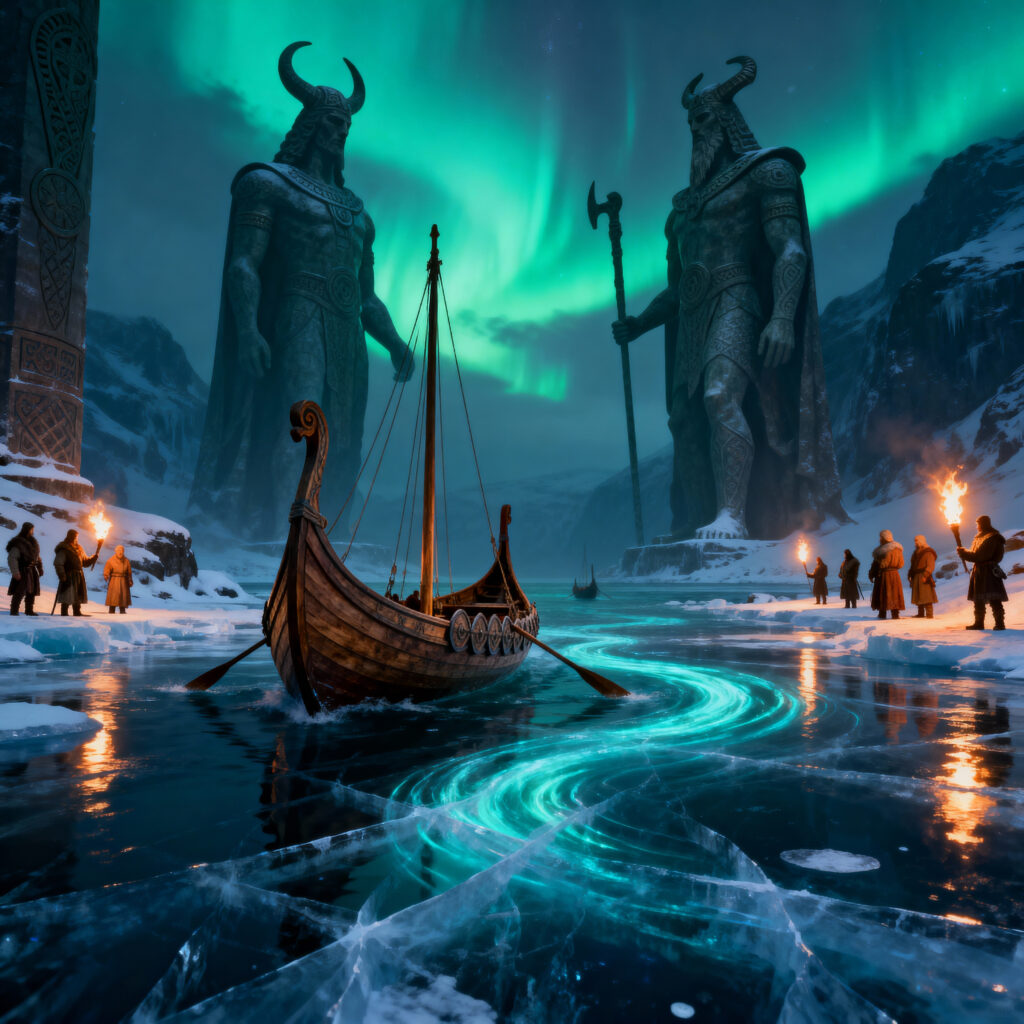
Longships glide beneath the aurora. Towering Anunnaki and early Norse settlers stand on the frozen shore, flames of torches reflected on the icy sea.
⚡ ANUNNAKI PARALLELS IN NORSE MYTH

Odin, the one-eyed seeker of wisdom, mirrors Enki, Lord of Earth and patron of knowledge. His self-sacrifice upon Yggdrasil echoes Enki’s defiance of the Flood decree to save humankind.
Thor reflects Ninurta/Apollo, while Freyja embodies Inanna-Ishtar, goddess of love and war. Loki’s cunning ambition evokes Marduk, the rebel prince.

Odin-Enki, Thor-Ninurta, and Freyja-Inanna stand together on the Bifröst Bridge as auroras shimmer above.
The Bifröst Bridge, a glowing arc between Asgard and Midgard, represents an ancient plasma corridor—perhaps a stargate linking realms.
✨ SUBSTACK INVITATION
🌌 Love ancient mysteries and cosmic origins?
Subscribe to our Substack for in-depth explorations of history, mythology, and the extraterrestrial legacy of humankind.
👉 Join us on Substack
Stay connected with Sasha & Janet’s continuing Anunnaki Chronicles series.
🔱 THE VIKING AGE (793–1066 CE)
The Viking Age began with terror and thunder at Lindisfarne in 793 CE. The longships emerged from fog like specters, bringing steel and fury to a holy isle. Thus began a saga of sea kings who conquered, traded, and settled — their voyages driven by divine ancestry and ancestral memory.

Vikings storm the monastery; the sea churns, lightning flashes, monks flee. Realistic historical epic style, landscape orientation.
From Britain to Byzantium, they carved their legend — part myth, part memory of a cosmic heritage that never fully died.
🛡️ HEROES AND DYNASTIES
Ragnar Lothbrok
The serpent-slayer whose laughter echoed in the pit of vipers — son of semi-divine Ynglings descended from the gods of Uppsala.

Ragnar and Lagertha side by side in battle—fierce eyes, armor reflecting firelight—symbolizing divine masculine and feminine courage.
Rollo of Normandy
From raider to ruler, he accepted land and a princess, founding the line of William the Conqueror.

Rollo before the gates of Paris, one hand extended in treaty, the other resting on his sword; the city’s cathedral towers in the mist behind.
Leif Erikson
The dreamer who reached Vinland centuries before Columbus.

Canute the Great
King of the North Sea Empire, who brought order to England through law and faith.
Harald Hardrada
The last great Viking — a hero who died at Stamford Bridge, marking the end of an era.

🜃 The Anunnaki Continuum: From Mesopotamia to the Northmen
The story of the gods did not end in Sumer. It evolved—migrating with their descendants, spreading through language, lineage, and sacred architecture that marked the Earth with purpose. The Viking Age was not the beginning of something new but the continuation of something eternal: the guidance of Enki, Ninmah, and Thoth as humanity’s divine teachers.
Enki and the Northern Expansion
When the Anunnaki withdrew from open rule, Enki’s influence remained through his priest-scientists—those who carried the memory of cosmic navigation, metallurgy, and genetic craft. They journeyed north along the great rivers and coastlines, following the geomagnetic pathways that hum with planetary energy. By the time the Norse sagas were sung, Enki’s wisdom had already taken root as the archetype of Odin—the wise wanderer, keeper of forbidden knowledge, and protector of humankind.
Enki’s compassion flowed through the myths of the North just as it had through Sumer and Egypt. The All-Father who sacrificed himself for wisdom was another face of the same lord who once defied the command to destroy humankind.
Ninmah and the Northern Goddess Line
Ninmah—known in different lands as Ninhursag, Hathor, Isis, and later Freyja—embodied the living principle of partnership consciousness. Through her line came healers, seer-queens, and shieldmaidens: women who remembered their cosmic ancestry and the sacred duty of balance between the masculine and feminine forces of creation.
Freyja’s magic, the seiðr, was not sorcery but science—a method of altering frequencies, opening portals, and harmonizing with the energy fields that Thoth would later map into geometry.
Thoth: The Architect of the Grid

Thoth stands at the heart of a glowing henge beneath the auroras, his blue and gold robes shimmering like the heavens he commands. Before him lies a circular stone altar carved with runes and sacred geometry, radiating a pulse of turquoise energy through the Earth. A serpent coils beside him—symbol of life and the current of creation—while his staff channels lightning into the ley lines that web the planet. Behind him, the stones of the ancient circle hum with power, connecting Earth’s magnetic field to the stars above. This is Thoth as the master engineer, the keeper of geometry and frequency, aligning worlds through knowledge and light.
Thoth, son and student of Enki, was the keeper of planetary architecture. Across epochs, he established schools of sacred engineering: aligning temples, henges, and pyramids to the ley lines that pulse beneath the Earth’s crust. In Britain and Northern Europe, his disciples constructed circular stone arrays—Stonehenge, Avebury, and the lesser henges—that served as harmonic resonators for cosmic energy.

Each structure was more than a monument—it was a transmitter. Built on geomagnetic nodes, these henges drew power from the Sun, Moon, and stars, creating a planetary network that linked Earth’s consciousness with the heavens. The runes, like the Egyptian hieroglyphs and Sumerian tablets before them, encoded the frequencies of this sacred geometry.
The Vikings inherited these energy sciences not through conquest but through ancestry. When their poets spoke of the Bifröst Bridge—the rainbow path linking Earth and Asgard—they described not merely myth but the visible aurora that crowned the old henge sites, pulsing with electromagnetic brilliance that Thoth had long ago learned to harness.
The Hidden Continuum
From Sumer to Egypt, from the Isles to the North, the same celestial lineage guided humanity’s evolution. Enki taught compassion and intelligence; Ninmah bestowed the power to heal and create; Thoth provided the blueprint for civilization’s architecture—both physical and energetic.
Though empires rose and fell, their frequency persisted. The Norse gods, like those of Greece and Egypt before them, were echoes of the same divine family—an ancient alliance that has never truly left this world. And now, as the Age of Aquarius dawns, that lineage stirs once more.
💫 CONCLUSION
Ea Enki adds: The Vikings were the SEA PEOPLE or Raiders of the Bible known as the Philistines. Archaeologists recently uncovered a Philistine graveyard revealing Northern European DNA, bridging myths and migrations across millennia.
📚 REFERENCES
- U in History / Mythology: “The Viking Era — The Brutal Warriors, The Culture and the Norse Mythology.” (Sept 21, 2024).
- Comparative Mythology Notes, Lessin Archives.
- ANUNNAKI: EVOLUTION OF THE GODS by Sasha & Janet Kira Lessin.
✨ CONNECT & SUBSCRIBE
🌟 Continue the journey with us!
Discover more about Enki, the Anunnaki, and humanity’s divine origins.
💌 Subscribe to our Substack: dragonattheendoftime.substack.com
Follow and share:
- 🌐 www.dragonattheendoftime.com
- 🌀 www.enkispeaks.com
- 🕊️ Facebook & X: @AquarianMedia
#Vikings #Anunnaki #Odin #Enki #NorseMythology #RagnarLodbrok #Lagertha #Valhalla #Nibiru #AncientAliens #AncientGods #AnunnakiHistory #PartnershipConsciousness #SpiritualEvolution #AncientAstronautTheory #EnkiSpeaks #AquarianMedia #SashaLessin #JanetKiraLessin #CosmicOrigins #WarriorSpirit #HistoryRevealed
Ea Enki adds: The Vikings were the SEA PEOPLE or the Raiders in the Bible known as the Philistines. A few years ago, an exhumed Philistine graveyard revealed DNA of Northern European peoples.
Reference: U in History / Mythology – “The Viking Era: The Brutal Warriors, the Culture and the Norse Mythology.” September 21, 2024.
Please like and share.
🎭 CAST OF CHARACTERS
| Name | Role | Anunnaki Counterpart |
|---|---|---|
| Odin | All-Father, wisdom seeker | Enki (Ea) |
| Thor | Storm and thunder god | Ninurta (Apollo) |
| Freyja | Goddess of love and magic | Inanna (Ishtar) |
| Loki | Trickster, shapeshifter | Marduk |
| Ragnar Lothbrok | Heroic semi-divine king | Hybrid descendant of the Æsir |
| Shieldmaidens | Female warriors | Priestesses of Freyja-Inanna |
✍️ AUTHOR BIOS
Dr. Sasha Alex Lessin, Ph.D. (Anthropology, UCLA) — An archaeologist of consciousness exploring ancient astronaut theory through myth, genetics, and comparative religion.
Janet Kira Lessin — Contactee, experiencer, researcher, and author, weaving personal experience with Anunnaki history to reveal humanity’s galactic heritage.
Together, they direct Aquarian Media and The Anunnaki Chronicles, bridging myth and science to awaken planetary consciousness.
🗝️ TAGS
Vikings, Anunnaki, Norse Mythology, Enki, Odin, Freyja, Ragnar Lothbrok, Ancient Aliens, Ancient Astronaut Theory, Partnership Consciousness, Spiritual Evolution, Nibiru, Scandinavian History, Cosmic Origins, Aquarian Age, Dragon at the End of Time, Sasha Lessin, Janet Kira Lessin
THE ANUNNAKI ANALOGS: VIKINGS AND THE GODS WHO WALKED THE NORTH
By Sasha Alex Lessin, Ph.D. (Anthropology, UCLA)
*Co-author with Janet Kira Lessin of ANUNNAKI: EVOLUTION OF THE GODS
The Echo of the Gods
Long before the Vikings carved their dragon-prowed ships, northern Europe was already haunted by stories of visitors from the stars — the Anunnaki, beings who engineered humankind from their own genome and seeded civilizations around the globe.
By the time Scandinavia’s ice melted, the memory of those radiant teachers had become myth. They were the Æsir, the giants, the gods of Asgard — immortal, beautiful, and wise.
From Nibiru to Asgard
To the Norse, Asgard was a fortress in the heavens connected to Earth by Bifröst, the rainbow bridge. Ancient-astronaut theorists read this as a memory of a luminous plasma tunnel — a stargate once used by beings who could traverse worlds.
Odin, the one-eyed wanderer, mirrors Enki, Lord of Earth and Keeper of Knowledge. Odin’s sacrifice upon Yggdrasil for the runes recalls Enki’s defiance of Enlil to save humanity from the Deluge. Both rebelled in the name of compassion.
Thor, storm-bringer and defender, reflects Ninurta/Apollo, while Freyja mirrors Inanna/Ishtar, goddess of both love and war. Loki, the trickster, echoes Marduk, Enki’s restless son, whose ambition reshaped empires.

The Dawn of the Viking Age
In 793 CE, the monks of Lindisfarne looked up from prayer to see longships slicing through the mist. The attack that followed shocked Christendom — but for the Norse, it was a sacred act of destiny.
They returned home with treasure and tales of glory, believing they were carrying out the will of their divine ancestors.
From Britain to Byzantium, their voyages echoed the Anunnaki impulse — to explore, to build, to conquer, to remember.
Ragnar and the God-Born Kings

Ragnar and Lagertha stand face to face at sunset, their armor catching the glow of dying firelight as storm clouds rise behind them. The scene captures their bond—love and war—two spirits forged by battle, drawn together by destiny. Around them, the horizon blazes with light and shadow, symbolizing passion, courage, and the eternal balance between masculine and feminine strength.
Ragnar Lothbrok, serpent-slayer and father of heroes, traced his lineage to the Ynglings — semi-divine descendants of Odin-Enki.
His sons — Bjorn Ironside, Ivar the Boneless, Sigurd Snake-in-the-Eye — spread Norse dominion across Europe, guided by omens and dreams they believed came from the gods. From their conquests would rise Rollo of Normandy, whose bloodline produced William the Conqueror, binding Viking destiny to the throne of England.
ings. The same spark that moved the Vikings across the sea now moves humanity toward the stars.
Photojournalistic Layout & Captions
| Spread # | Title / Caption | Scene Description & Prompt Notes |
|---|---|---|
| 1 | Arrival in the North | Anunnaki star-ship over Arctic coastline; proto-Vikings gaze upward, aurora behind. Landscape, realistic, cinematic. |
| 2 | Odin and Enki Across Time | Split-portrait: left Enki in Sumerian robes, right Odin in wolf-fur and runes; shared one blue eye glowing. |
| 3 | The Raid on Lindisfarne | Longships in stormlight; monks flee; sky crackling with lightning. Epic realism. |
| 4 | Ragnar’s Lineage | Montage of Ragnar and his sons with ancestral holographic image of Enki above. |
| 5 | Shieldmaidens of Freyja | Women warriors in bronze armor under Northern Lights, eyes glowing with fierce compassion. |
| 6 | The Anunnaki Continuum | Montage of Ragnar and his sons with an ancestral holographic image of Enki above. |
| 7 | Return of the Star Gods | Montage of Ragnar and his sons with an ancestral holographic image of Enki above. |
Substack Call-to-Action
✨ Explore the Continuum.
Join our global community of readers as they discover how ancient gods still shape the modern world.
💌 Subscribe at dragonattheendoftime.substack.com
Reference & Further Reading
- U in History / Mythology: “The Viking Era — The Brutal Warriors, The Culture and the Norse Mythology” (2024)
- Sasha & Janet Kira Lessin, Anunnaki: Evolution of the Gods
- Comparative Mythology Archives, Aquarian Media Research
Authors
Dr. Sasha Alex Lessin, Ph.D., Anthropology (UCLA) — An archaeologist of consciousness bridging ancient astronaut theory with human origins.
Janet Kira Lessin — Contactee, researcher, and author, revealing the continuing Anunnaki presence through personal experience and historical investigation.
Together, they direct Aquarian Media and The Anunnaki Chronicles.
Tags
Vikings, Anunnaki, Enki, Ninmah, Odin, Freyja, Ragnar Lothbrok, Norse Mythology, Ancient Aliens, Partnership Consciousness, Spiritual Evolution, Nibiru, Ancient Astronaut Theory, Cosmic Origins, Aquarian Media, Dragon at the End of Time, Sasha Lessin, Janet Kira Lessin

See the article with illustrations at:
By Sasha Alex Lessin, Ph.D. (Anthropology, UCLA), co-author (with Janet Kira Lessin) of ANUNNAKI, EVOLUTION OF THE GODS — techno-savvy extraterrestrial people from the Planet Nibiru who came for gold, created us from their genome to work the mines, posed as gods, decided to let us drown, but then decided to breed us to work for them.
🕊 X / TWITTER DESCRIPTION
What if Asgard and Nibiru were the same? Two names for one celestial realm — the dwelling place of gods, scientists, and star voyagers who watched over Earth. The Bifröst was no myth; it was a bridge between worlds. ✨
#Asgard #Nibiru #Anunnaki #AncientAliens #MythologyRevealed #Enki #Ninmah #Thoth #Bifrost
📘 FACEBOOK DESCRIPTION
In the Anunnaki cosmology, Asgard and Nibiru mirror one another — luminous sanctuaries orbiting beyond human reach, connected by energy bridges once traversed by the gods. The Bifröst was not fantasy but memory: the plasma corridors of the sky, where Enki, Ninmah, and Thoth moved between Earth and the stars. Discover how Norse and Sumerian legends tell the same cosmic story. 🌌
Read more: Asgard and Nibiru — Mirror Worlds of the Gods
🏷 TAGS (separated by commas)
Asgard, Nibiru, Anunnaki, Enki, Ninmah, Thoth, Bifröst, Valhalla, Norse mythology, Sumerian gods, ancient astronauts, planetary origins, sacred science, orbital sanctuaries, divine technology, rainbow bridge, ancient wisdom, mythology revealed, cosmic connection, stargates, spiritual evolution




